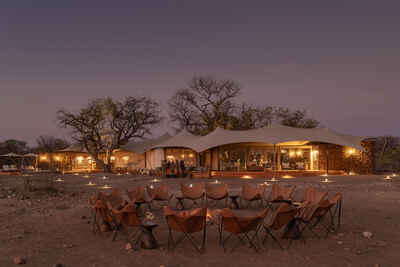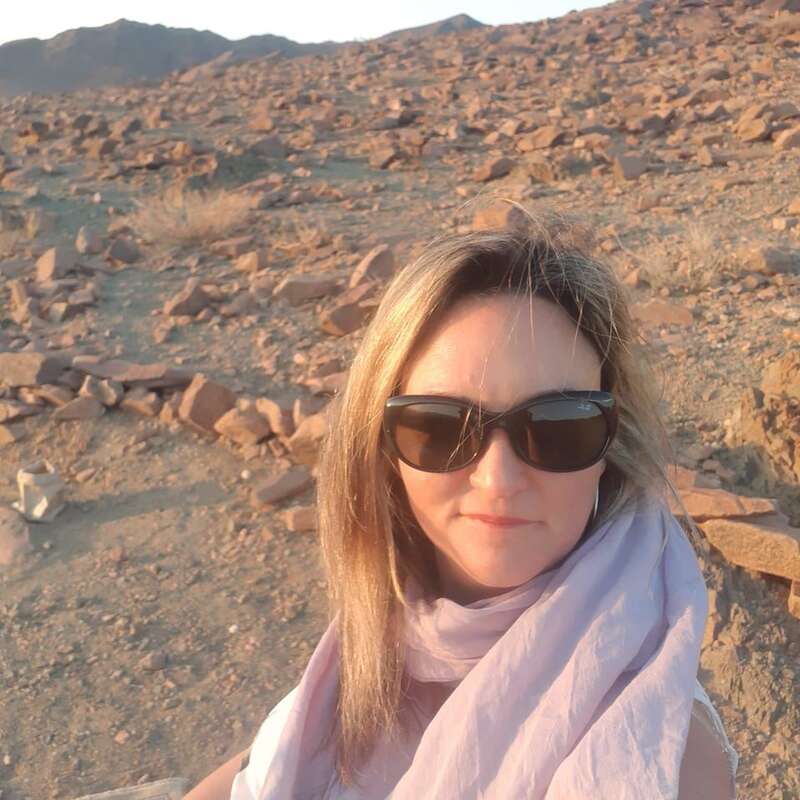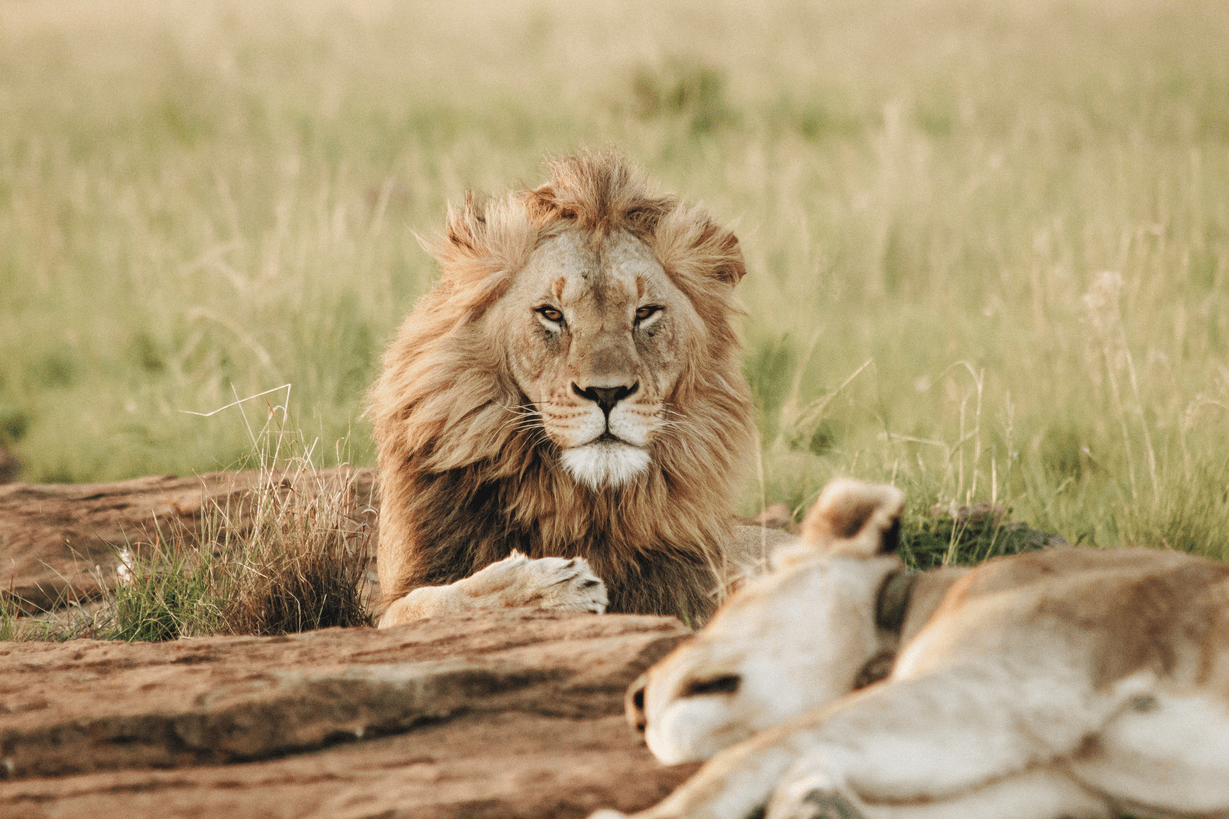About Desert Rhino Camp
To track black rhino on foot from Desert Rhino Camp is one of the world's most thrilling wildlife adventures.
Deep in the Palmwag Reserve, these rare animals are protected by the Save the Rhino Trust. Their desert home – like the camp's – is truly remote, the sense of wilderness enhanced by the sheer scale of the reserve.
To encounter a rhino on foot is a truly heart-pounding moment. Set off each morning to explore the desert home of these prehistoric-looking animals, a world shared with giraffe and elephant, lion and hyena. When rhinos are spotted, it's time to leave your 4WD in favour of walking, in the hands of expert guides and the rhino rangers, who have years of rhino-tracking experience.
A picnic lunch in the desert is a further highlight, before returning to your contemporary oasis. Cooling off in the plunge pool might be your priority, or freshening up in your outdoor shower, before relaxing on your private veranda looking out over the desert – or indulging in afternoon tea and cake.
As the sun sets behind the mountains, the flickering light of the campfire beckons, backed by a floodlit waterhole beneath the magic of the Namibian night sky. To pull yourself away is to follow the sandy paths to a warm and comfortable bed, or even – for extra adventure – to sleep under the stars.
Our view
Desert Rhino Camp is definitely one of our favourite camps in Namibia. It's very remote, and feels it; it's got tremendous character, as had the manager when we've visited; and it offers the chance to track black rhinos – which is something that's possible in very few places indeed. The camp does work as a two-night stop, but to make the most of it, you need three nights here. This may appear to be a big chunk of time, and it's not an inexpensive camp – but we think that Rhino Camp is well worth it.
Accommodation
6 suites
Children
Best for 16+
Open
All year
Activities

4WD Safari

Birdwatching

Guided walking safari

Private activities
Traveller reviews of Desert Rhino Camp
120 real, un-edited reviews from Expert Africa's travellers.
Arrived 2 Jun 2025, 2 nights
"Desert Rhino Camp review"
Overall rating: Excellent
Arrived 11 Apr 2025, 3 nights
"Desert Rhino Camp review"
Overall rating: Excellent
Arrived 3 Mar 2025, 3 nights
"Desert Rhino Camp review"
Overall rating: Excellent
Arrived 19 Feb 2025, 2 nights
"Desert Rhino Camp review"
Overall rating: Excellent
Arrived 23 Sep 2023, 2 nights
"Desert Rhino Camp review"
Overall rating: Excellent
Arrived 18 Sep 2023, 3 nights
"Desert Rhino Camp review"
Overall rating: Excellent
Arrived 24 Jun 2023, 2 nights
"Desert Rhino Camp review"
Overall rating: Excellent
Arrived 11 May 2023, 3 nights
"Desert Rhino Camp review"
Overall rating: Excellent
Arrived 26 Oct 2022, 3 nights
"Desert Rhino Camp review"
Overall rating: Excellent
Arrived 10 Sep 2022, 3 nights
"Desert Rhino Camp review"
Overall rating: Excellent
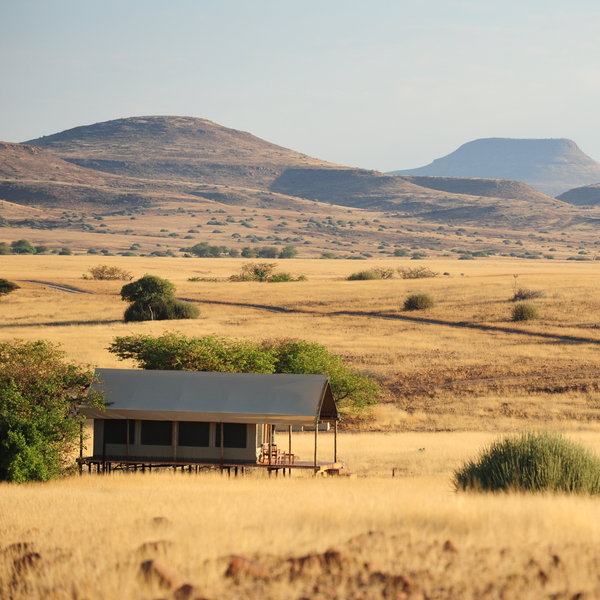
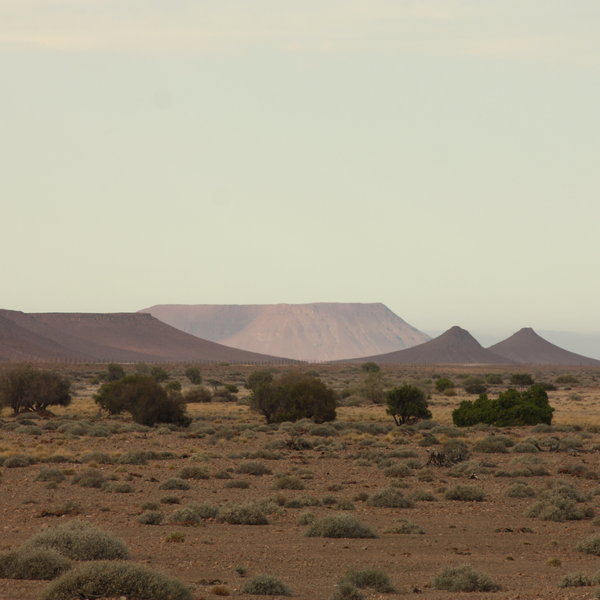
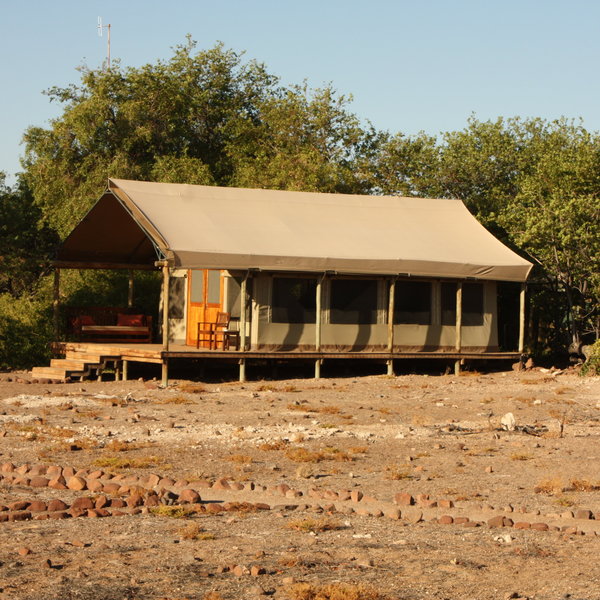
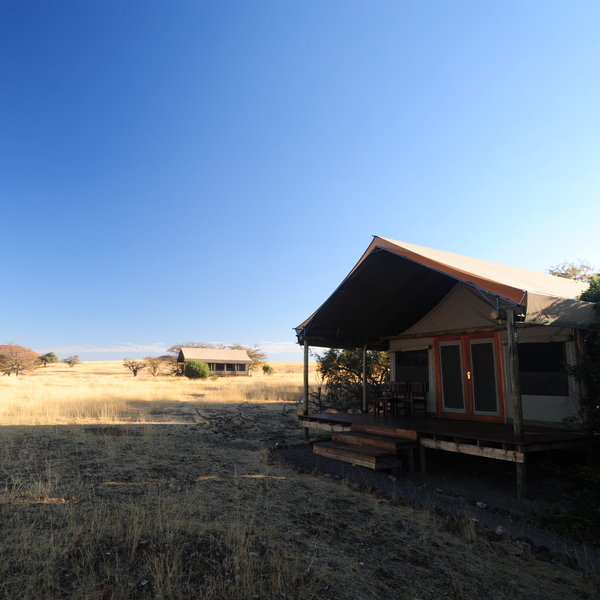
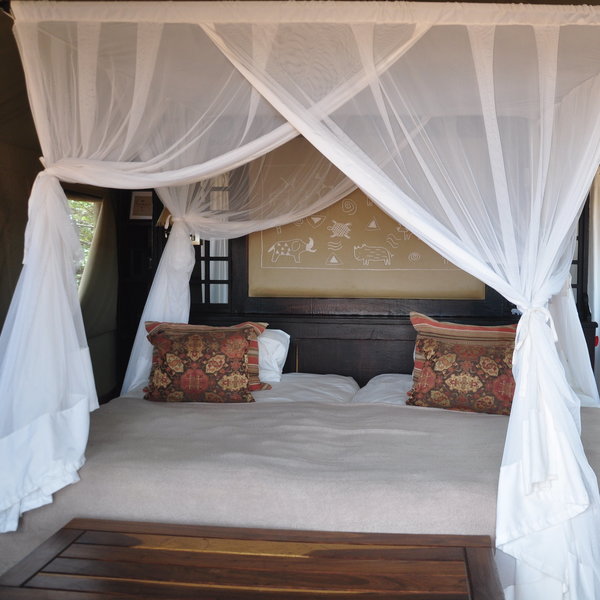
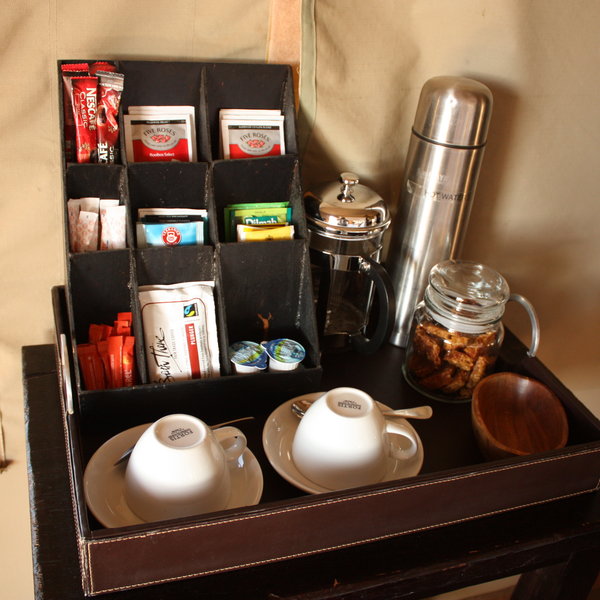
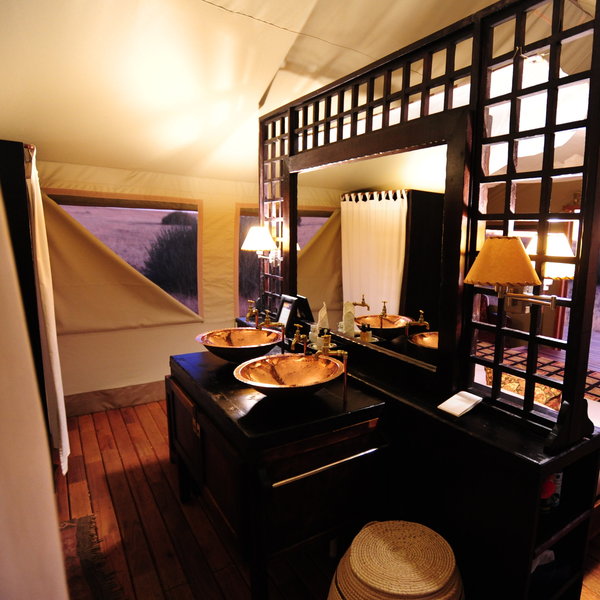
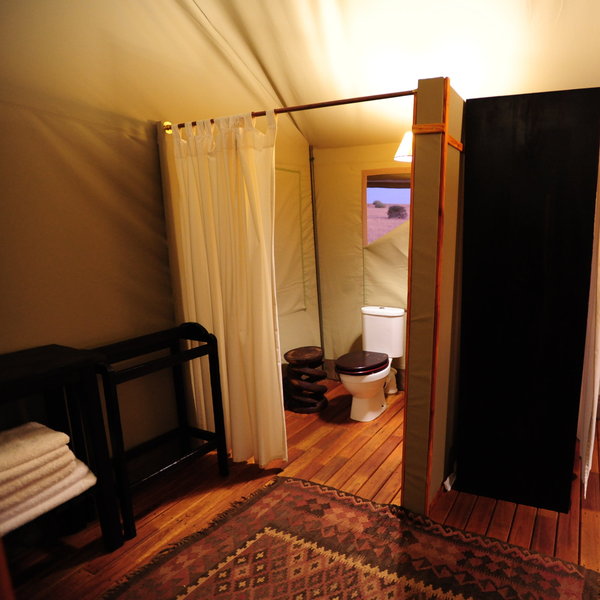
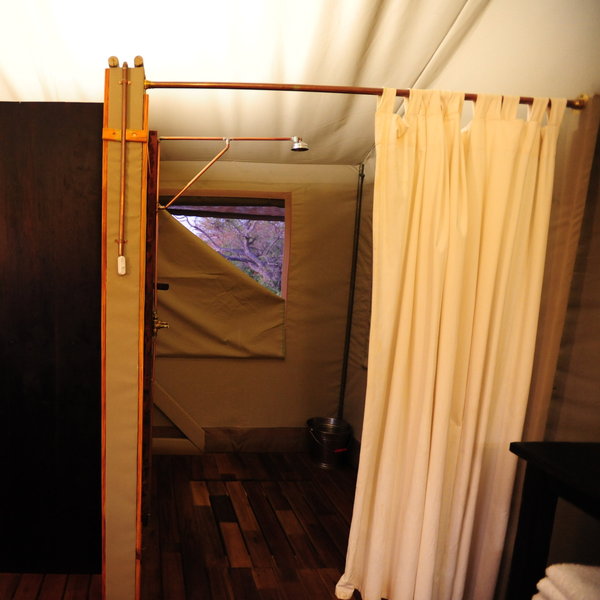
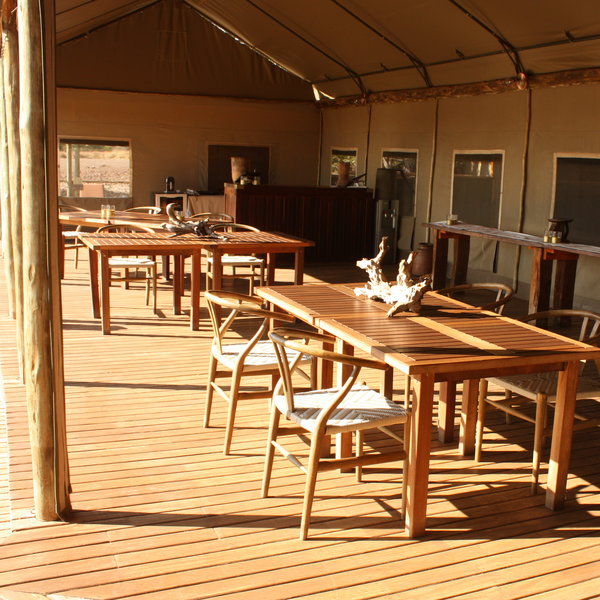
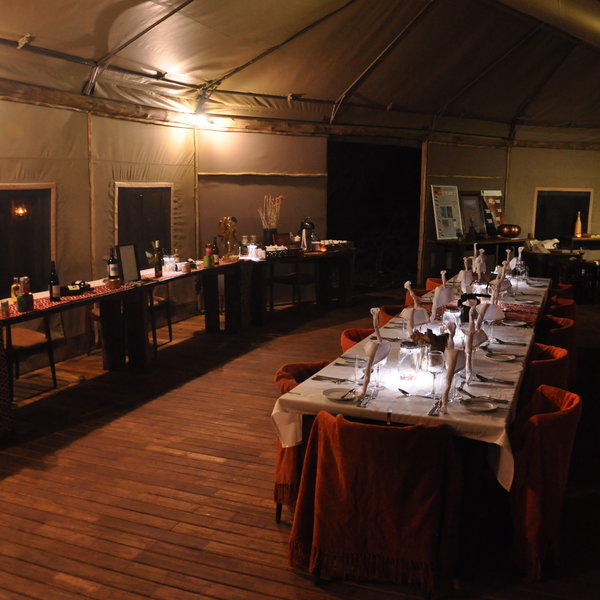
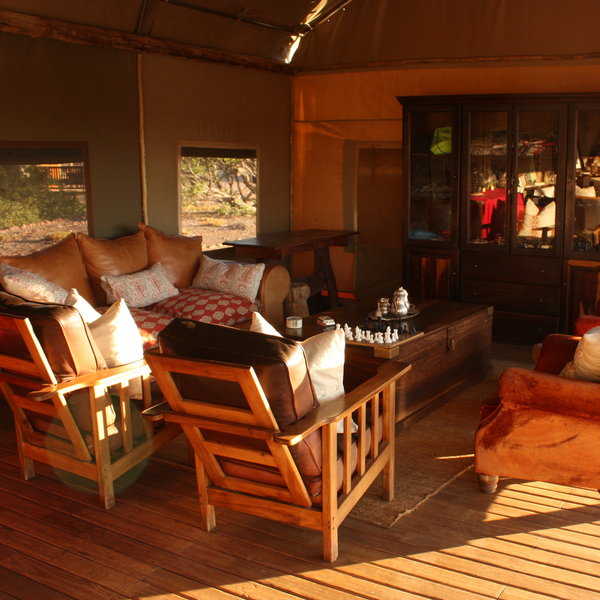
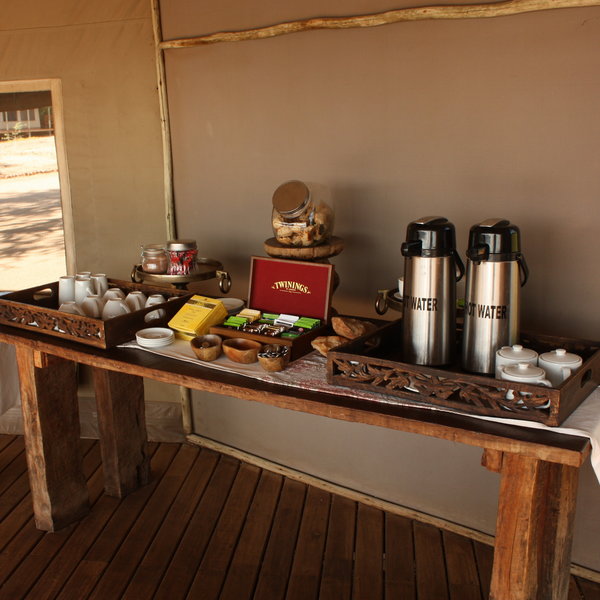
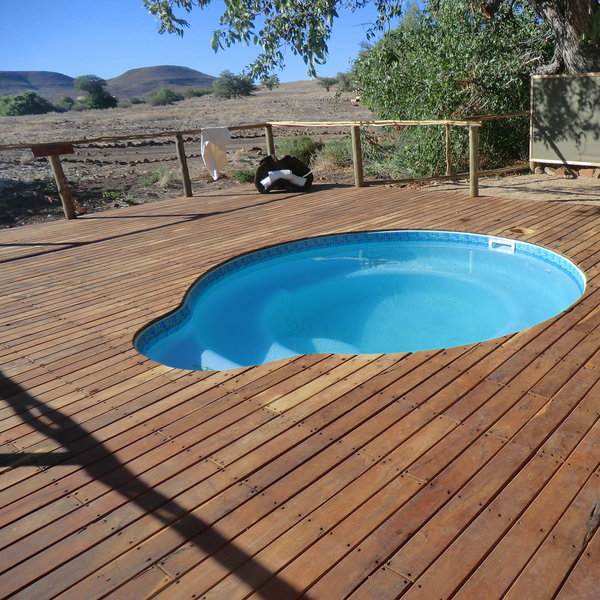
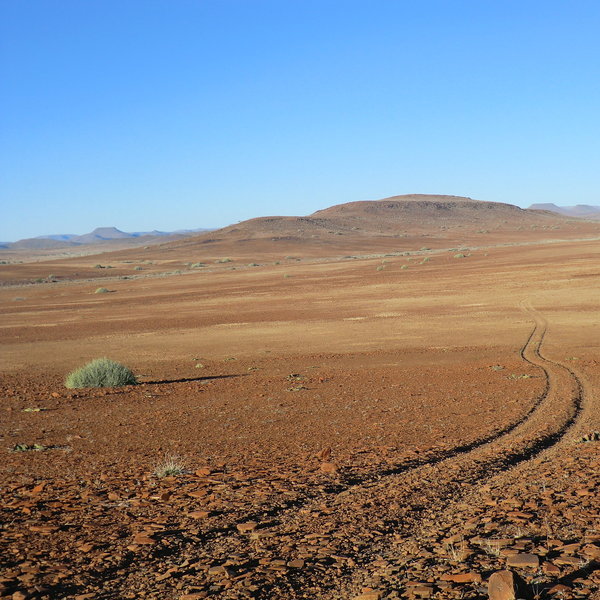
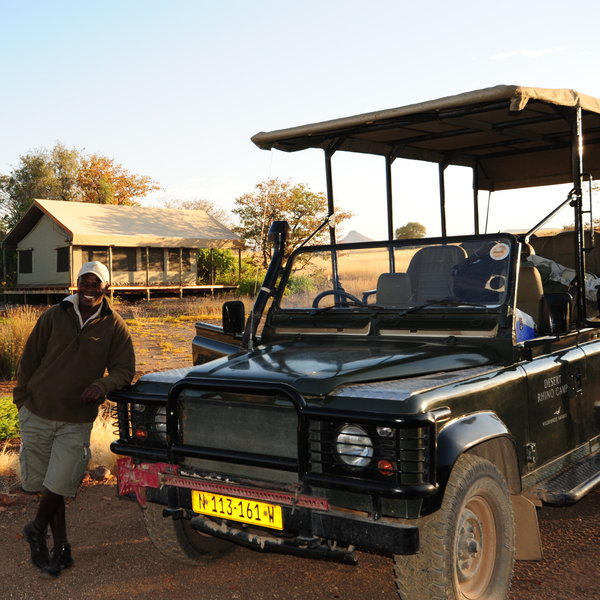
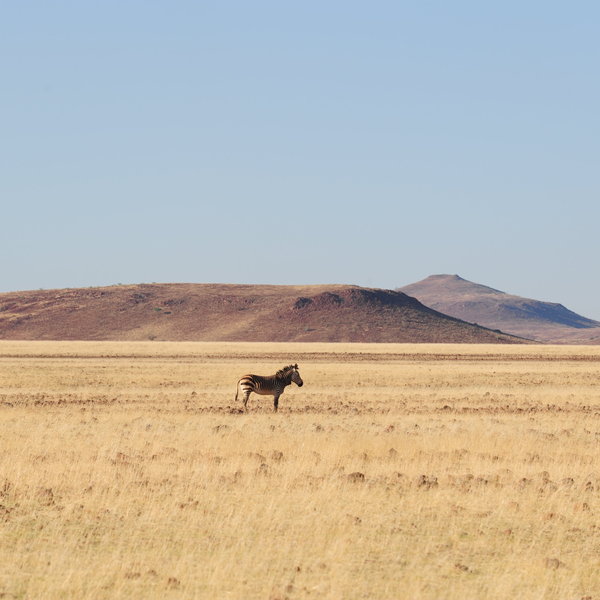
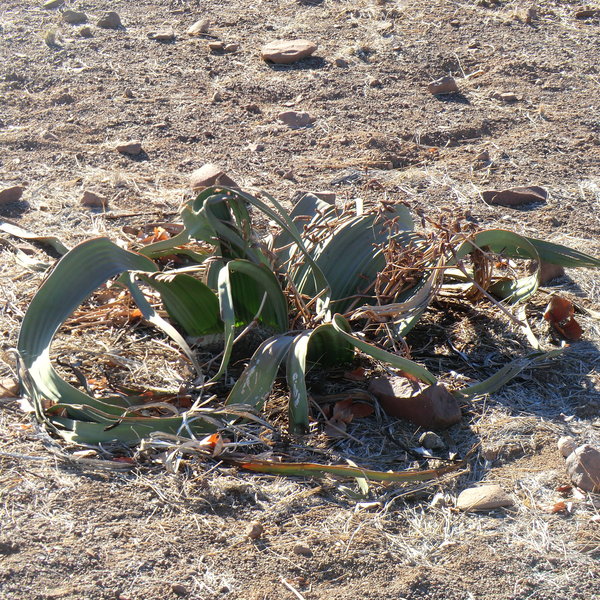
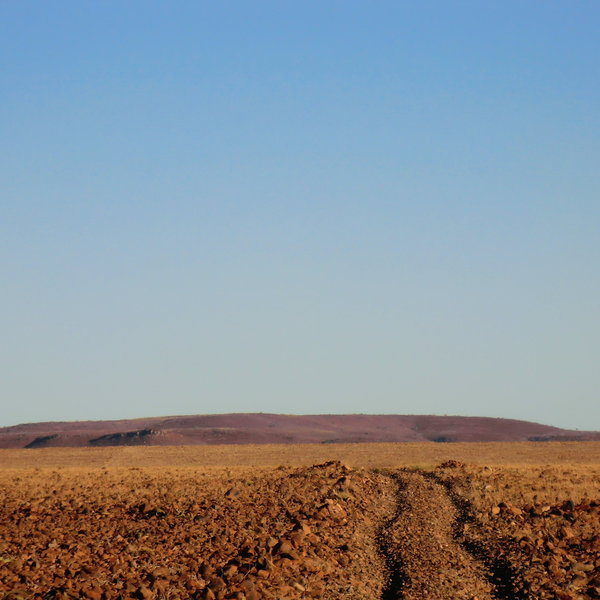
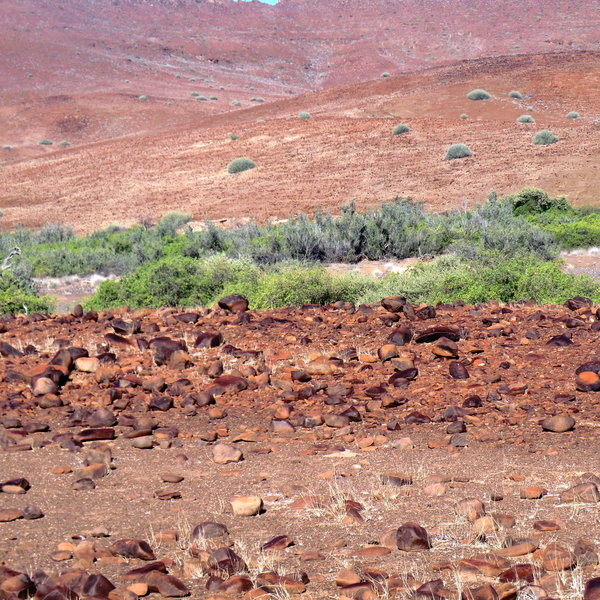
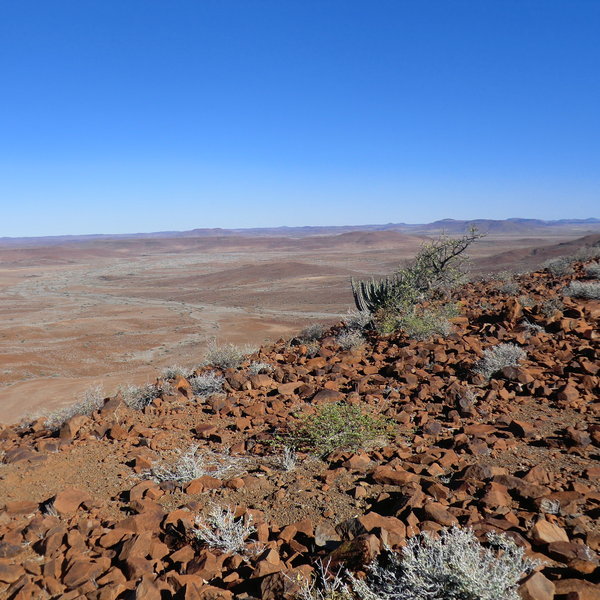
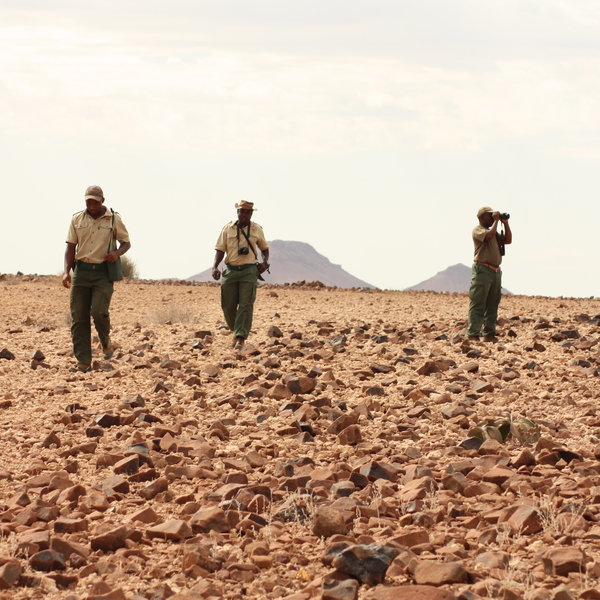
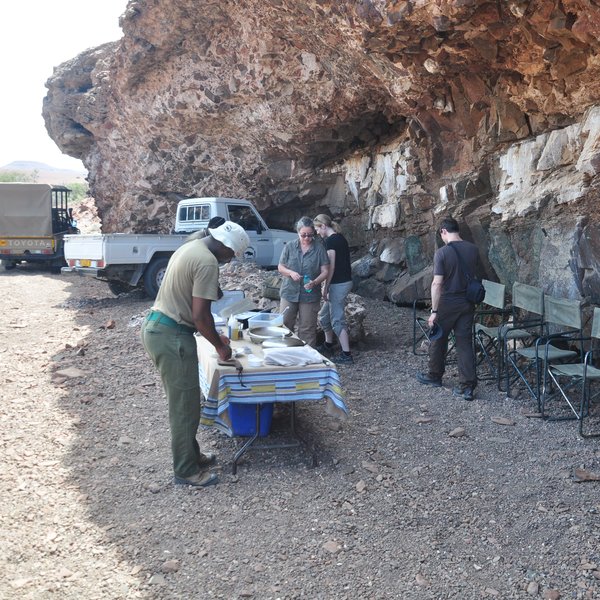
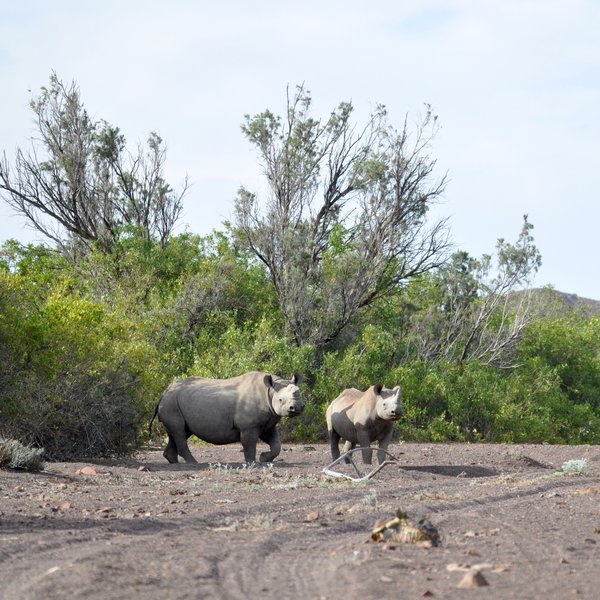
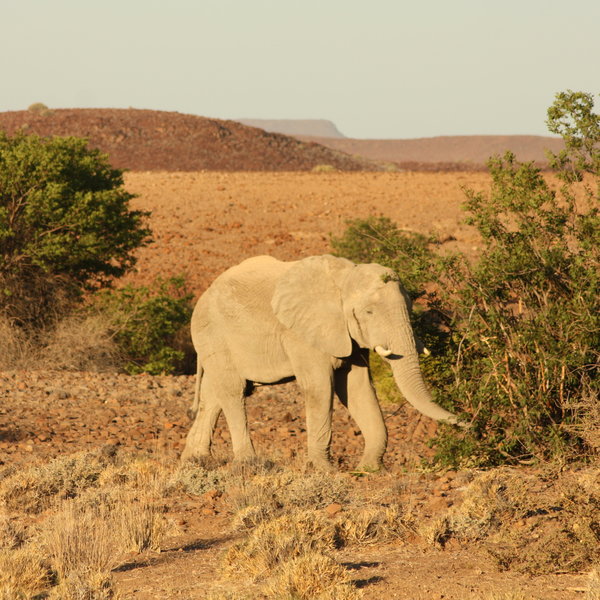
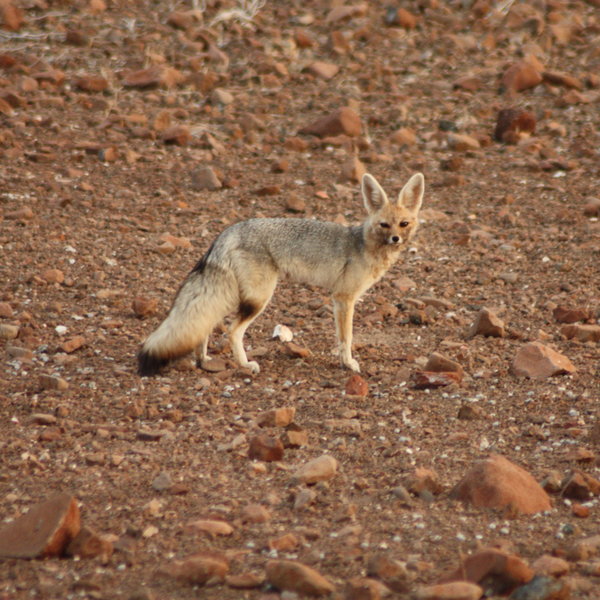
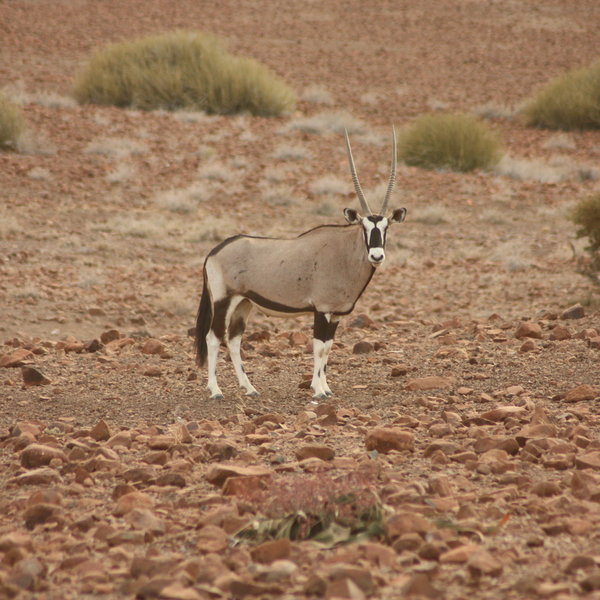
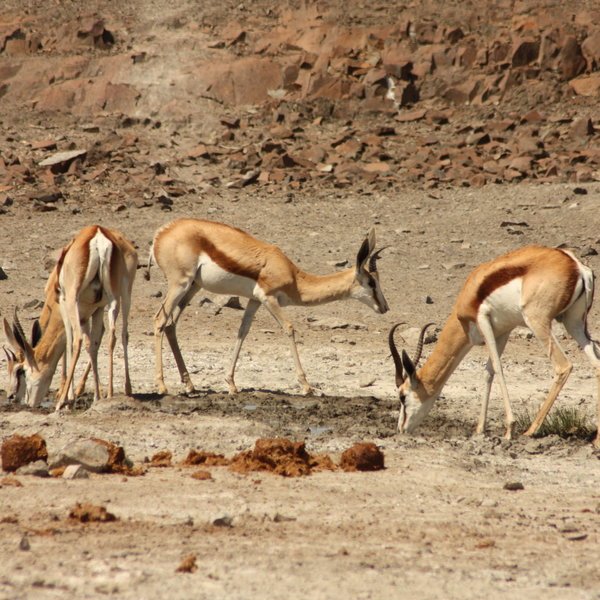
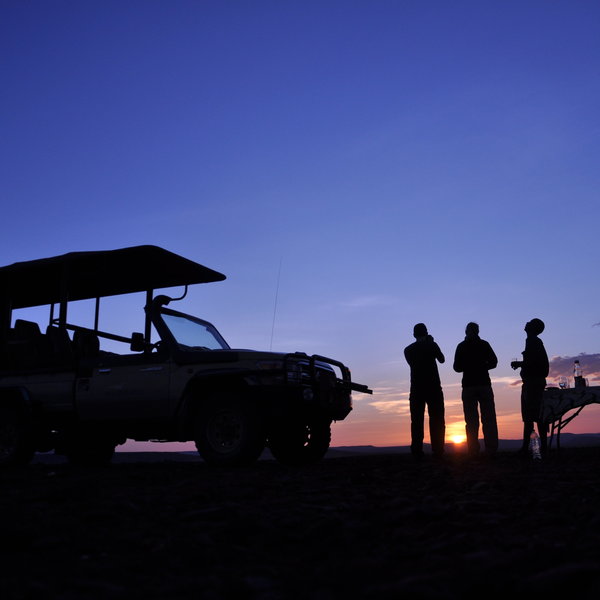
Expert Africa's gallery
When we travel we take lots of photos ourselves to give you a real and un-edited view of the safaris. See our 54 pictures and 1 videos of Desert Rhino Camp to get the candid view.
View gallerySafaris visiting Desert Rhino Camp
Just ideas, we'll always tailor-make a trip for you
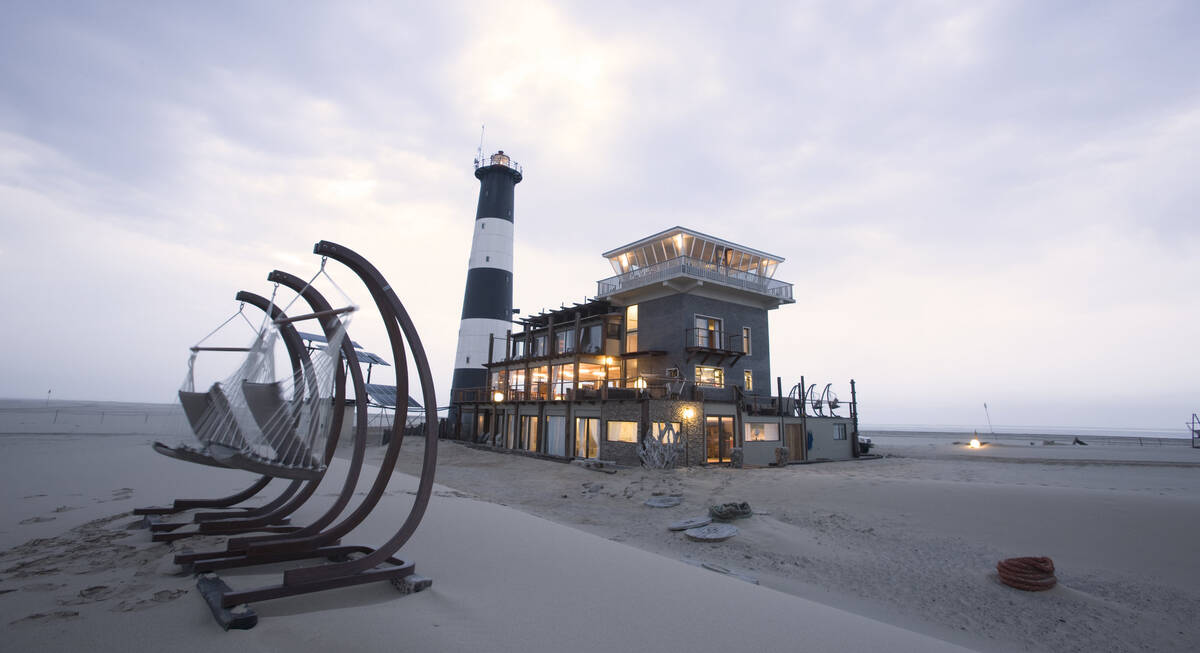
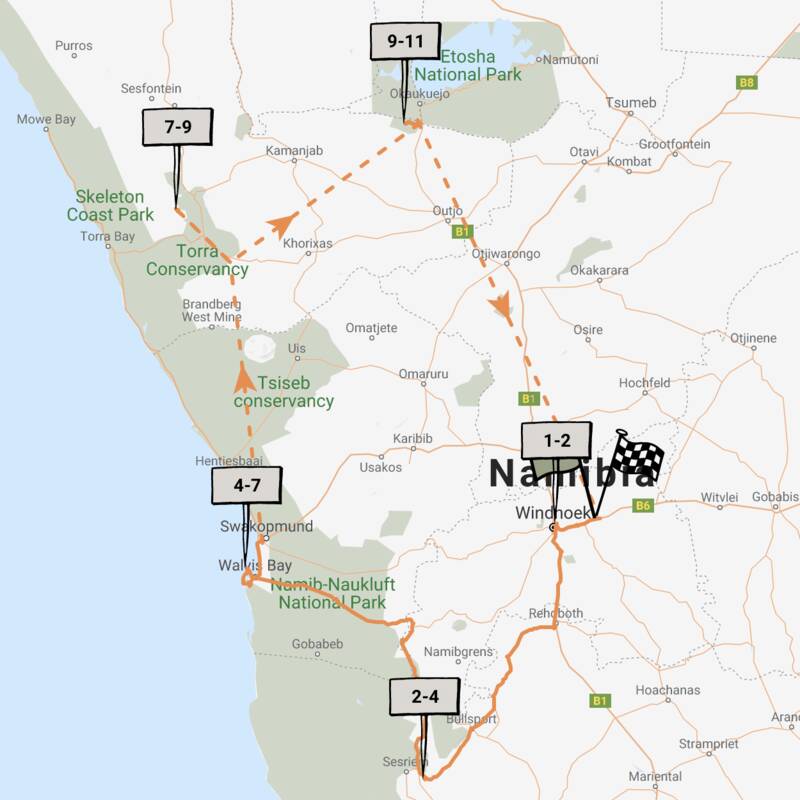
Pelican Fly & Drive Safari
10 days • 5 locations • 1 country
WINDHOEK AIRPORT TO WINDHOEK AIRPORT
A unique itinerary visiting the must-see highlights combining the adventure of a classic Namibian self-drive with the ease and spectacular views of a fly-in safari.
Visiting Namib-Naukluft, Damaraland and 3 other areas
US$8,320 - US$8,860 per person
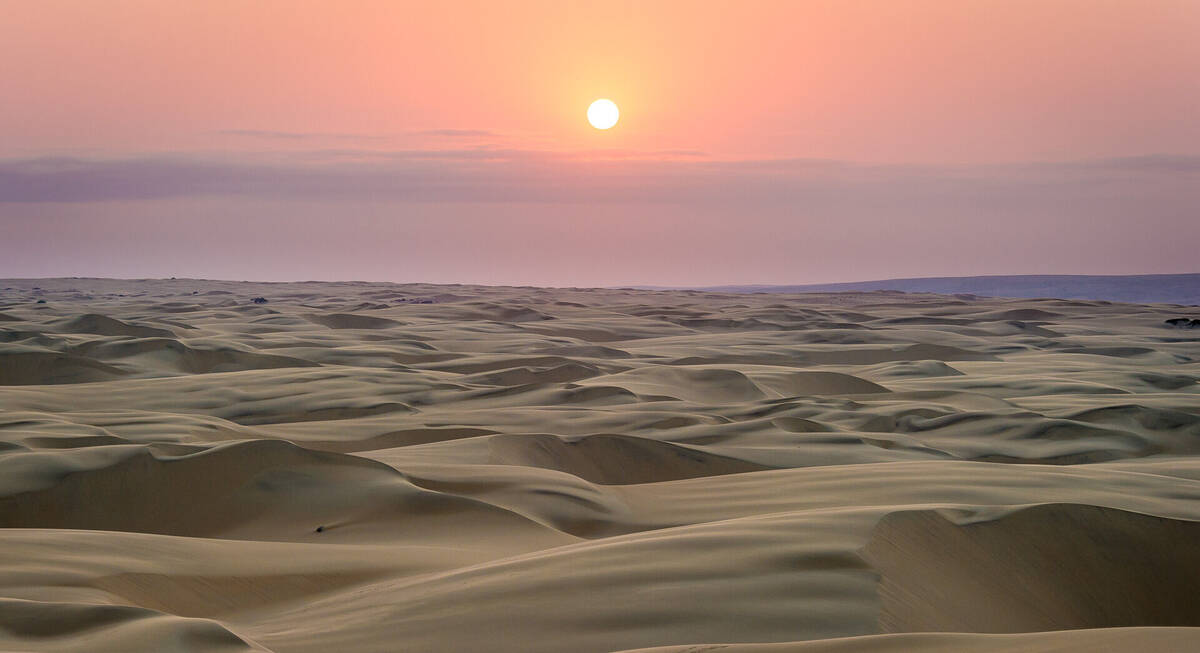
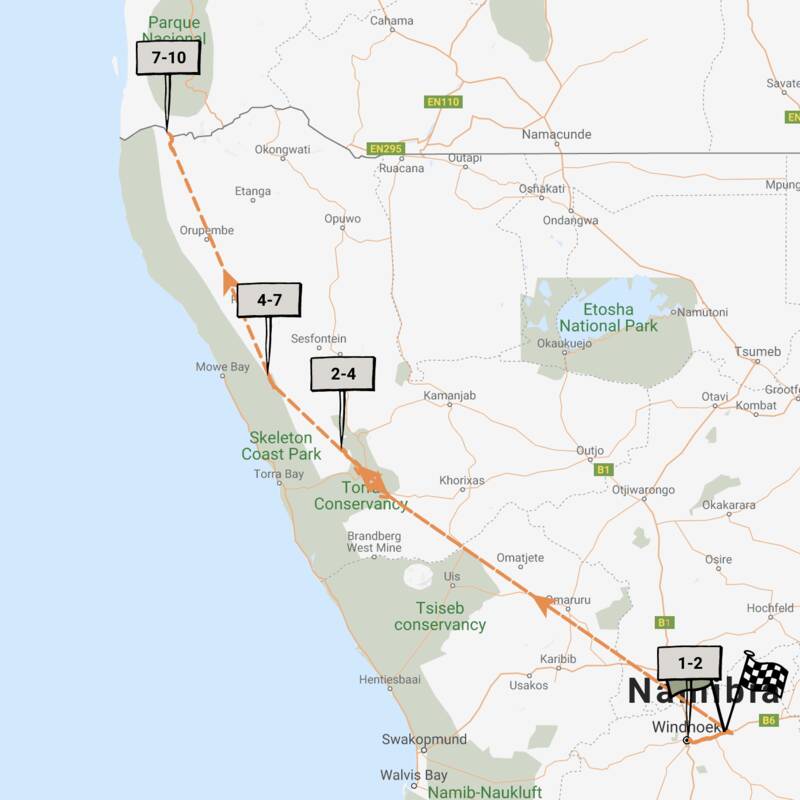
Ruppell's Korhaan Fly-in Safari
9 days • 4 locations • 1 country
WINDHOEK AIRPORT TO WINDHOEK AIRPORT
Explore Namibia’s remotest wildernesses while staying at some of the most exclusive luxury camps in the country. This epic fly-in safari will deliver otherworldly landscapes, fascinating wildlife and genuine cultural experiences.
Visiting Damaraland, Skeleton Coast and 1 other area
US$11,410 - US$16,910 per person
Desert Rhino Camp: Our full report
Remote, exclusive and specialised, Desert Rhino Camp lies in the vast Palmwag Concession.
This semi-desert reserve of about 5,000km² between Etosha National Park and the Skeleton Coast is one of the best places to see desert-dwelling black rhino and other desert-adapted wildlife. Fully rebuilt in 2024, the camp has been operating for more than 20 years and its activities – run by a reliably superb and committed team – centre on tracking black rhino.
A joint venture between Namibia's Save the Rhino Trust and Wilderness Safaris, Desert Rhino Camp – founded in 2003 – was formerly known as Palmwag Rhino Camp. Few camps are so remote, and have such a large area that they can call their own. The Palmwag Concession (or Palmwag Reserve) has a number of tree-lined, freshwater springs that support good populations of the rare Hartmann's mountain zebra, giraffe, oryx, springbok and kudu. It is also one of the best places to see desert-dwelling black rhino, as well as predators including lions, cheetah, leopard, and brown and spotted hyena, although sightings of these are rare.
When we visited the rebuilt camp in April 2025, we were thrilled to experience the newly reimagined camp; what a transformation! While it remains in its breathtaking original location, the upgrades have elevated the experience to something truly exceptional.
The suites and main areas have been completely redesigned, blending modern comfort with the raw beauty of the wilderness. Thoughtful touches, elegant finishes and wide-open views make it feel both intimate and expansive—a perfect reflection of the desert surroundings.
Following its rebuild, Desert Rhino Camp has just six wood-and-canvas suites, one accommodating a family of four in two suites linked on a single deck. Throughout, the feel is contemporary, with neutral colours and extensive use of natural materials blending into the desert landscape.
Each suite is set on a low wooden plinth, a somewhat box-like structure beneath a stretched canvas roof that arches over the bedroom, veranda and bathroom, with a cushioned deck doubling as a star bed to take in the glories of the Namibian night sky.
Panoramic sliding glass doors on two sides open the bedroom to a wooden deck and the desert landscape beyond. Behind the king-size or twin beds a dramatic photograph of a rhino accentuates the role of this lodge in rhino conservation. Bedside tables flank the bed, while a comfortable ottoman sits at the foot. Simple rush matting softens the wooden floor, a ceiling fan stirs the air, and full-length curtains add a cosy feel – much appreciated during the cold winter months.
Stone walls partially encompass each suite, including an outdoor shower that is artfully designed to look almost like a mirror image of its indoor partner. Other bathroom components, including twin stone basins and hanging mirrors, lie behind the headboard, along with plenty of hanging and storage space.
An extensive wooden deck ensures that no aspect of this rugged landscape is missed – with outdoor seating ranging from comfortable easy chairs to directors' chairs around a small table. It all looks exceptionally well designed.
Sandy pathways lead from the suites to the main area, where the shade from a stretched canvas roof is enhanced by the presence of a gnarled old tree. From the lounge to the dining area to the bar, it is completely open at the front, offering views of the nearby waterhole – which is floodlit at night – and the mountains beyond.
Stone walls at the back and wooden flooring accentuate the overall design, with neutral fabrics covering armchairs and sofas, light-coloured wooden tables, and solid bar stools fronting a proper bar. A long dining table is positioned to take in the views, but roll down see-through blinds are a welcome addition come the cooler evenings; it can get very cold here!
In the heat of summer, a small, canvas-shaded plunge pool could be inviting, while a firepit surrounded by comfortable chairs comes into its own in the early morning or as the sun goes down.
For more than 30 years, the Save The Rhino Trust has been solely responsible for helping to protect the rare, desert-adapted black rhino. The majority of this species are found in north-west Namibia, where populations have increased steadily from about 40 in the early 1980s, and the Palmwag Concession boasts the largest population of black rhino outside of a national park anywhere in the world. A portion of the revenue from every guest at Desert Rhino Camp goes to the Trust, which has trained local people to patrol and monitor the rhino. It is with these trackers, some of whom are seconded to the camp, that you go out tracking.
Activities at Desert Rhino Camp are firmly focussed on rhino tracking. Each evening, guests taking part in the following day's rhino activity meet at camp for a chat with the trackers. They will explain their work and what you can expect during your activity. The next morning, you start out early in a 4WD vehicle, driving around the reserve and enjoying any wildlife you see. Meanwhile, the trackers are out and about, looking for the rhino. When they find one, they radio your guide and arrange to meet somewhere. You then go in closer on foot, with your guide, at a slow and steady pace. The trackers will always ensure that you stay a safe distance away, but the sheer exhilaration of being within a couple of hundred metres of a rhino whilst on foot more than makes up for the fact that you do not get right up to it. Note that given the open terrain and the rarity of the rhinos, the trackers are not armed – but they are well-trained.
Although the walking isn't very strenuous, the terrain is very uneven as the landscape is strewn with small rocks and boulders. Sure-footedness and sturdy walking shoes are therefore recommended. Note, too, that the days can be long, and you'll sometimes be out from 6.00am to 6.00pm. This can include bouncing around on uneven roads in an open-sided game vehicle, with potentially long periods when there's not a lot to see. This is especially likely in the rainy season (around November to March), when much of the wildlife in the area heads further north, out of the concession.
During our most recent stay, in April 2025, we were lucky enough to see two separate black rhino. Despite it being a long and dusty day, we thoroughly enjoyed it, thanks in no small part to our enthusiastic, knowledgeable and personable guide who really brought the desert to life,
Activities
4WD Safari
Birdwatching
Guided walking safari
Private activities
Families & children
- Attitude towards children
- Desert Rhino Camp does not accept children under the age of 6. It is important to note, too, that children must be 16 years of age or older to track rhino on foot.
- Property’s age restrictions
- Children need to be over 6 years of age. Families visiting with children aged 6 –16 years must pay for a private vehicle. Children under 16 may not track rhino on foot, in line with Save the Rhino Trust regulations.
- Special activities & services
- At Desert Rhino Camp, the "Bush Buddies" programme is designed to engage younger guests in meaningful and educational experiences during their stay, while introducing them to the local environment, wildlife and conservation efforts in an age-appropriate and interactive manner. Activities often including guided nature walks, the basics of wildlife tracking and cultural storytelling sessions.
- Equipment
- One family tent at Desert Rhino Camp incorporates two en-suite rooms, making it suitable for a family of four.
- Generally recommended for children
- We consider that Desert Rhino Camp is suitable for mature children over the age of 16.
- Notes
- Children are very much the responsibility of their parents or carers. If children misbehave on activities, the camp reserves the right to ask them to remain back in camp. Parents should also be aware that this camp is not fenced and dangerous wildlife can pass through, and there is obviously an inherent risk while tracking rhinos on foot.
Food & drink
- Usual board basis
- Full Board & Activities
- Food quality
- On our last visit, in April 2025, the food at Desert Rhino Camp was delicious. Vegetarians and most other dietary requirements can be catered for with advanced notice.
Breakfast is served bright and early, just before you head out for the day’s rhino-tracking adventure. Guests can help themselves to a light buffet featuring cereals, yoghurt, freshly baked bread and warm muffins – perfect for a gentle start to the morning.
For those after something more filling, a cooked breakfast is also available. The camp’s signature dish is especially popular with hungry adventurers: a tender minute steak served with crispy hash browns and a dollop of horseradish sauce – a hearty, flavourful boost before setting off into the wild.
Lunch is typically enjoyed as a picnic out in the bush—a wonderfully relaxed and scenic experience. We were treated to a generous and delicious spread that included both vegetable and meat lasagne, a hearty bean salad, classic Greek salad, a selection of cheeses, and freshly baked bread. To accompany the meal, there was a choice of soft drinks, beer and wine, making it feel like a proper alfresco feast.
Alternatively, if you return to camp for lunch, you might enjoy a refreshing greenhouse salad followed by a crispy pork schnitzel, beautifully paired with a glass of rosé or chilled chardonnay. Dessert was a rich, indulgent treat: a creamy tart made with condensed milk – simple, sweet and utterly satisfying.
Also in camp, afternoon tea of homemade cakes or savoury snacks is available at around 4.00pm, with tea and coffee.
Our dinner was a wonderfully sociable occasion, served in the boma, just 100m from camp. As the lanterns flickered and the stars emerged overhead, we gathered around a long, family-style table, ready for a feast that celebrated both flavour and tradition.
The evening began with a warming black bean soup, served in miniature potjie pots: rich, earthy, and full of character. This was followed by a mouth-watering buffet of Namibian favourites: tender lamb chops, juicy chicken, and flavour-packed sosaties (kebabs), accompanied by traditional pap with tomato-onion sauce, creamy potato salad and more. To end the night on a sweet note, we savoured red-wine poached pears: elegant, fragrant and the perfect complement to the smoky, hearty meal - Dining style
- Group Meals
- Dining locations
- Indoor and Outdoor Dining
- Further dining info, including room service
- Room service is not available.
- Drinks included
- All drinks are included, except for imported and premium brand wines and spirits.
The borehole water is not considered safe to drink but drinking water is provided.
Our travellers’ wildlife sightings from Desert Rhino Camp
Since mid-2018, many of our travellers who stayed at Desert Rhino Camp have kindly recorded their wildlife sightings and shared them with us. The results are below. Click an animal to see more, and here to see more on our methodology.

100% success

97% success

87% success

56% success

48% success

45% success

26% success

25% success

18% success

11% success

10% success

10% success
Getting there
- Location
- Damaraland, Namibia
- Ideal length of stay
- Three nights to make the most of the rhino tracking. Desert Rhino Camp often combines well with its sister camps, Little Kulala, Doro Nawas or Serra Cafema.
- Directions
- Desert Rhino Camp is a 5-minute transfer from the nearest airstrip. If you're arriving by road on a self-drive trip, it's a 2-hour scenic 4WD drive from the pick-up point at Twee Palms, further up the road from Palmwag Lodge, where you leave your car. The area is best accessed after a stay in southern Damaraland or western Etosha.
- Accessible by
- Self-drive or Fly-and-Transfer
Special interests
- Photography safaris
- For a photographic safari in Namibia, Desert Rhino Camp offers exceptional opportunities to capture the black rhino that wander this semi-desert region, along with other desert-adapted wildlife, while the dramatic scenery of the ancient Etendeka lava flows make for great landscape photography.
- See ideas for Photography safaris in Namibia
- Walking safaris
- Desert Rhino Camp concentrates on tracking Namibia's desert-dwelling black rhino. Typically you'll start in a vehicle, then after finding the animals, will approach them on foot led by well-trained (and unarmed) guides. It's a thrilling experience!
- See ideas for Walking safaris in Namibia
- Wildlife safaris
- Desert Rhino Camp is one of the best places in Africa to see black rhino roaming free, and to track them on foot. If your particular focus is on rhino, it makes a great place for a wildlife safari in Namibia.
- See ideas for Wildlife safaris in Namibia
Sustainability
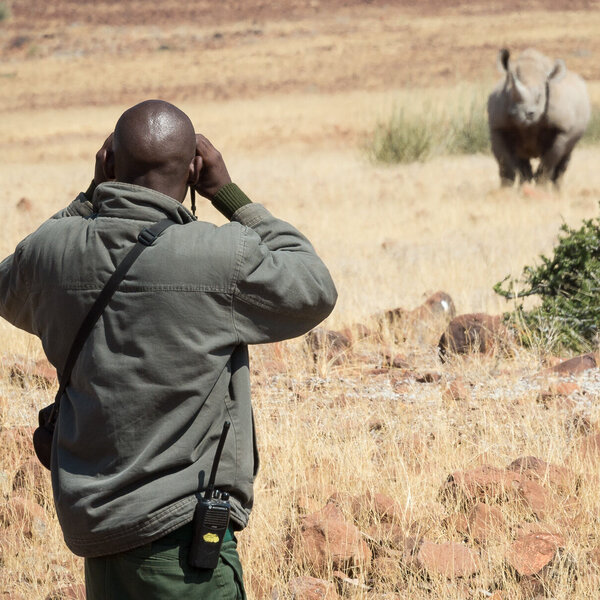
Save the Rhino Trust
Based in the Kunene Region in Namibia's northwest, Save the Rhino Trust Namibia (SRT) is a non-governmental organisation working to protect the area's population of desert-adapted black rhino (Diceros bicornis bicornis) – the only truly free-ranging population in the world. It was founded in 1982 by a group of local conservationists concerned about the decreasing number of rhino due to poaching.
Save the Rhino Trust Namibia (SRT) works closely with Save the Rhino International in the UK, which supports a number of rhino conservation programmes in both Africa and Asia.
Living outside of a fenced protected area, the Kunene's rhinos are considered to be the largest truly free-ranging black rhino population left in the world. These rhino are protected and monitored by staff from SRT, in conjunction with Namibia's Ministry of Environment and Tourism (MET) and local communities. A number of dedicated SRT patrolling and monitoring teams cover the core rhino range area of over 25,000 km22 (6.7 million acres). These teams deter poaching and record valuable data on individual rhino, such as age, sex, rhino horn size and shape, ear notches and condition. This information is shared with MET who maintain the Kunene Black Rhino database – one of the longest-running and most comprehensive databases on black rhino in the world. This data helps to inform biological management decisions on Namibia's black rhino population.
Other SRT activities include assistance to MET during translocation operations of desert-adapted black rhino into their former habitat to establish meta-populations, and to ensure the survival and growth of the species. Collaboration is fundamental to SRT success and part of their effort focuses on building up knowledge, understanding and skills within partner organizations – including communities, tour operators, government and the international community. An incentive-based training programme in certain conservancies provides community game guards with theoretical and practical training as well as field equipment, uniforms and transport – as well as incentive bonuses. A further activity involves presentation of scene-of-the-crime training courses to rhino stakeholders in the area.
Guests at Desert Rhino Camp can enjoy a unique rhino-tracking experience with SRT trackers, leaving camp in a 4x4 vehicle to search for the rhinos, before getting closer on foot – although not too close!
See more great sustainability projects in Namibia
Communications
- Power supply notes
- An extensive photovoltaic system creates solar power for all purposes.
It is possible to charge batteries in the tents. - Communications
- The camp has WiFi in the rooms, but not in the main area. There is no cellphone signal. There is a satellite phone for emergencies only.
- TV & radio
- There is no cellphone signal and no WiFi.
- Water supply
- Borehole
- Water supply notes
- The toilets and showers are fully plumbed and hot water is available via a solar-powered water heater.
Health & safety
- Malarial protection recommended
- Yes
- Medical care
- Desert Rhino Camp has a medical kit on site. The nearest doctor is in Outjo, but in an emergency guests would be airlifted to Windhoek.
- Dangerous animals
- High Risk
- Security measures
- Because the area is unfenced and because of the potentially dangerous wildlife, guests are escorted to and from their suites after dark by a guide.
There is an air-horn in each suite to attract attention in case of emergency. - Fire safety
- There are fire extinguishers in each suite and in central areas.
Useful info
- Disabled access
- On Request
- Laundry facilities
- Included
- Money
- There is an electronic safe in each suite. Currency exchange is not offered here.
- Accepted payment on location
- The camp accepts payment by Visa or Mastercard as well as cash in Namibian dollars and South African rand.
Plan and book your trip with Expert Africa
All of our trips are tailor-made, so we'll always adapt them to suit you. Talk to an Expert and let us plan and arrange your perfect trip.

Talk to an Expert
Call or email us now! We’ll match you with the Specialist in our team who is best suited to help you. Then together we can start planning your trip.

Set up your itinerary
Based on our experience and your ideas, your specialist will create a detailed, costed itinerary. We’ll refine it together, until we have a trip that you’re perfectly happy with.

Prepare for your trip
The same Specialist will make the seamless arrangements for your trip, send you detailed travel documents, and be available to answer any questions before you depart.

Travel with peace of mind
After you set off, you’ll be cared for by our partners in Africa, most of whom have worked with Expert Africa for decades. And if you ever need us urgently, we’re available 24/7.

When you return
We love to learn about your trip, and so will always be grateful if you’ve the time to give feedback to your Specialist when you return.
Desert Rhino Camp's location
Look closer at the environment and surroundings of Desert Rhino Camp.
Other lodges in Damaraland
Alternative places to stay in this same area.
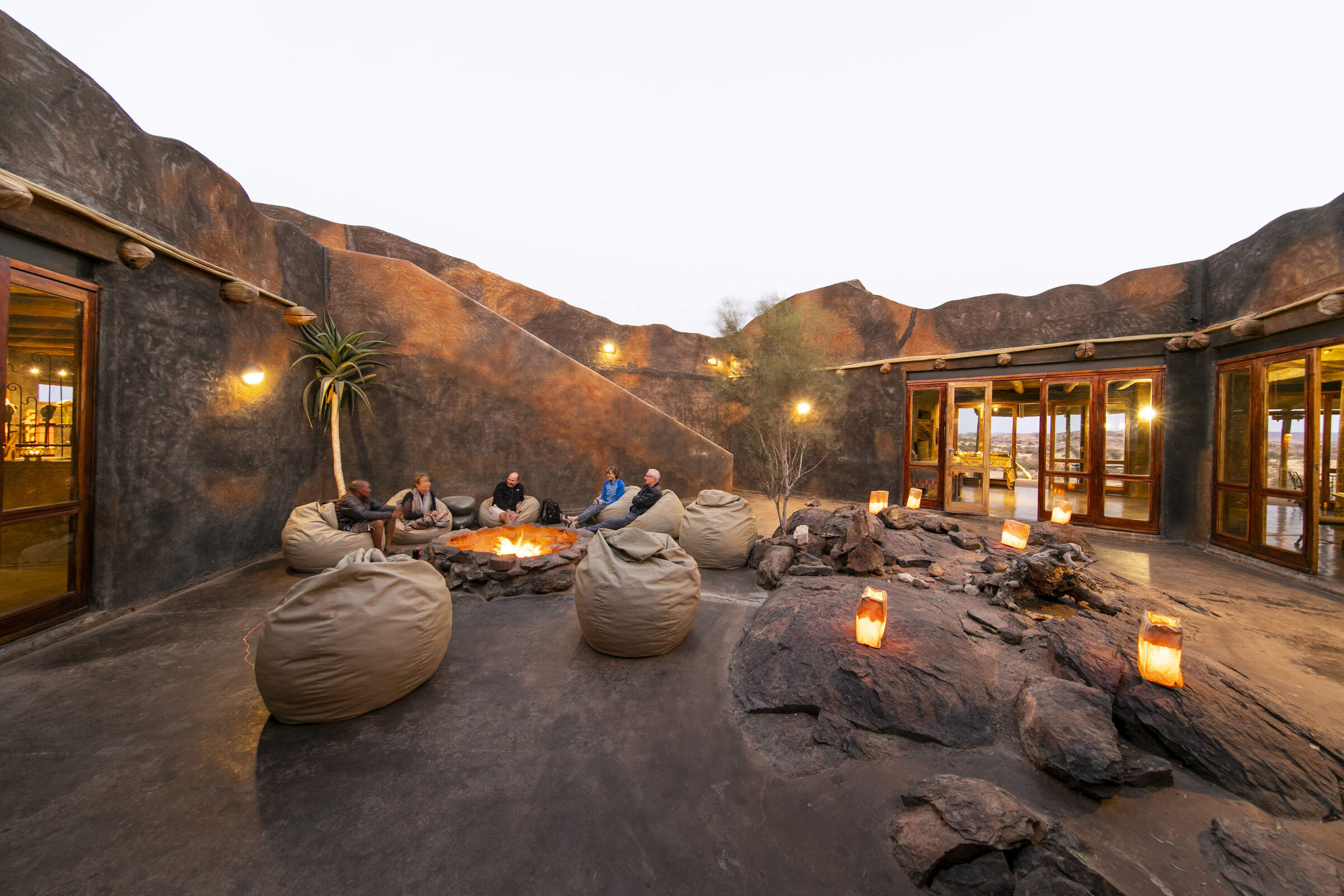
Doro Nawas
Comfortable rooms and a convenient location make the community run Doro Nawas a great base for exploring Damaraland.
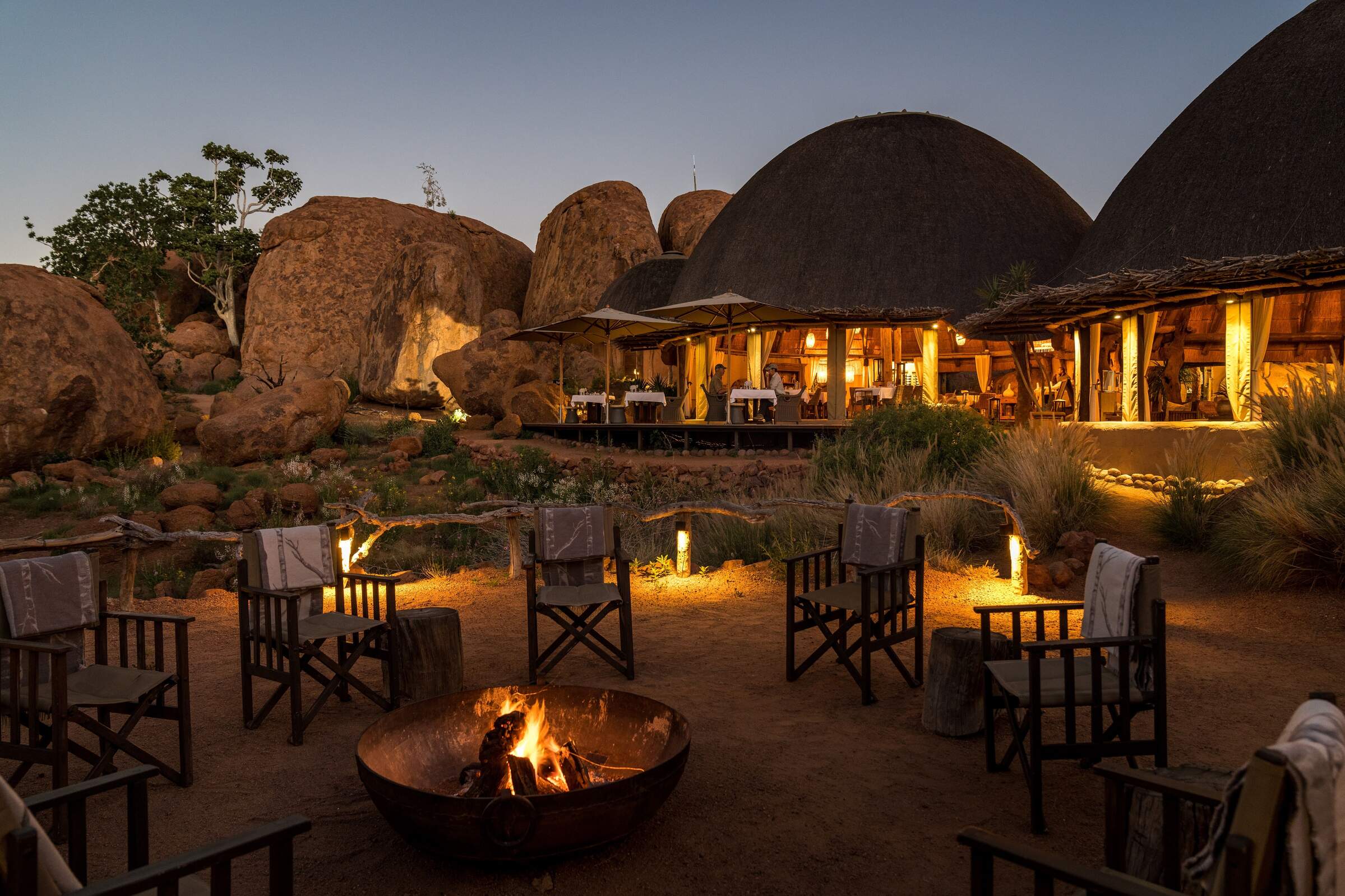
Mowani Mountain Camp
Mowani is a beautiful and stylish mountain retreat in southern Damaraland; it makes a great base for visits toTwyfelfontein.
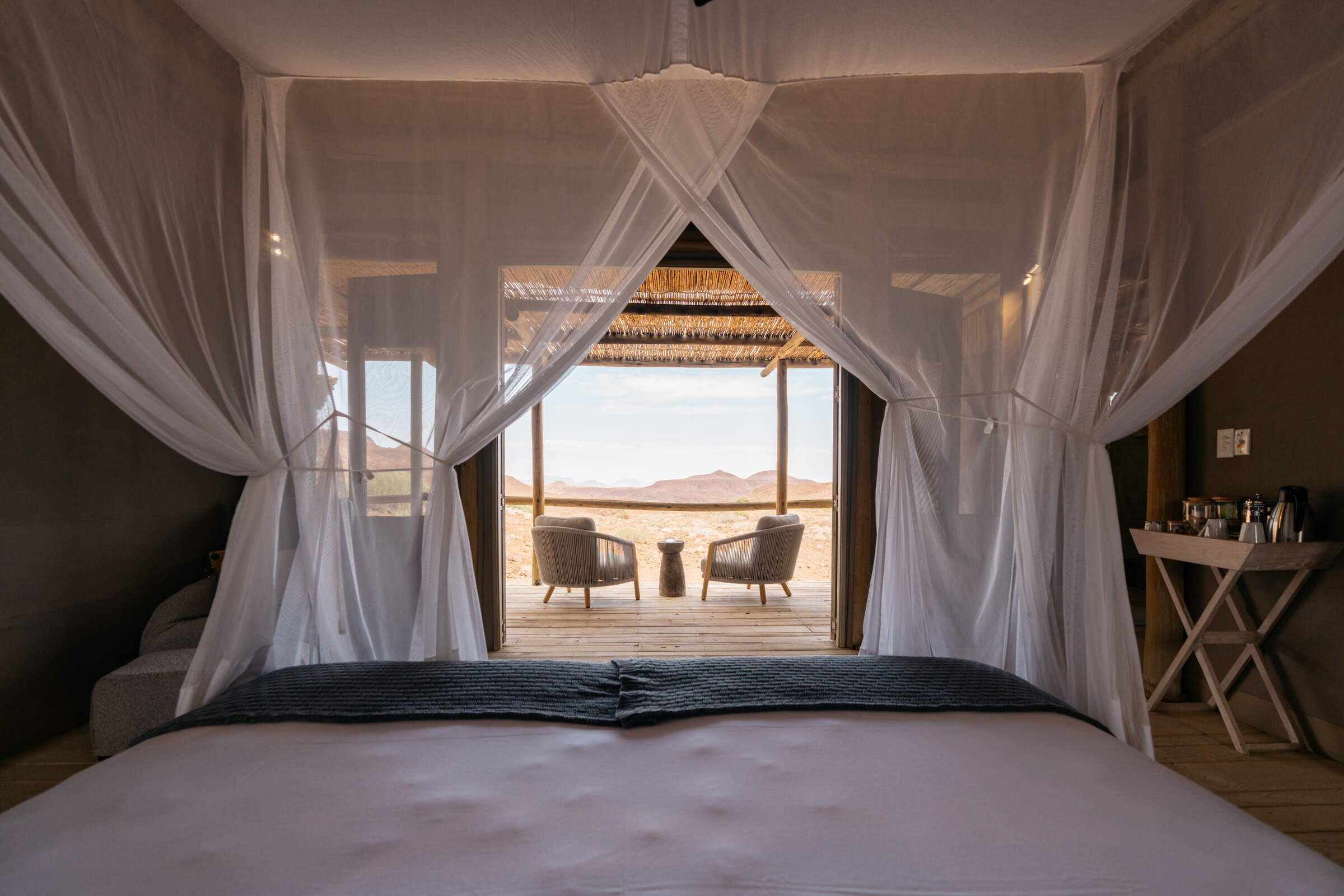
Damaraland Camp
Setting the standard for community partnerships, Damaraland Camp offers a beautiful location, a range of activities – and a genuine welcome.
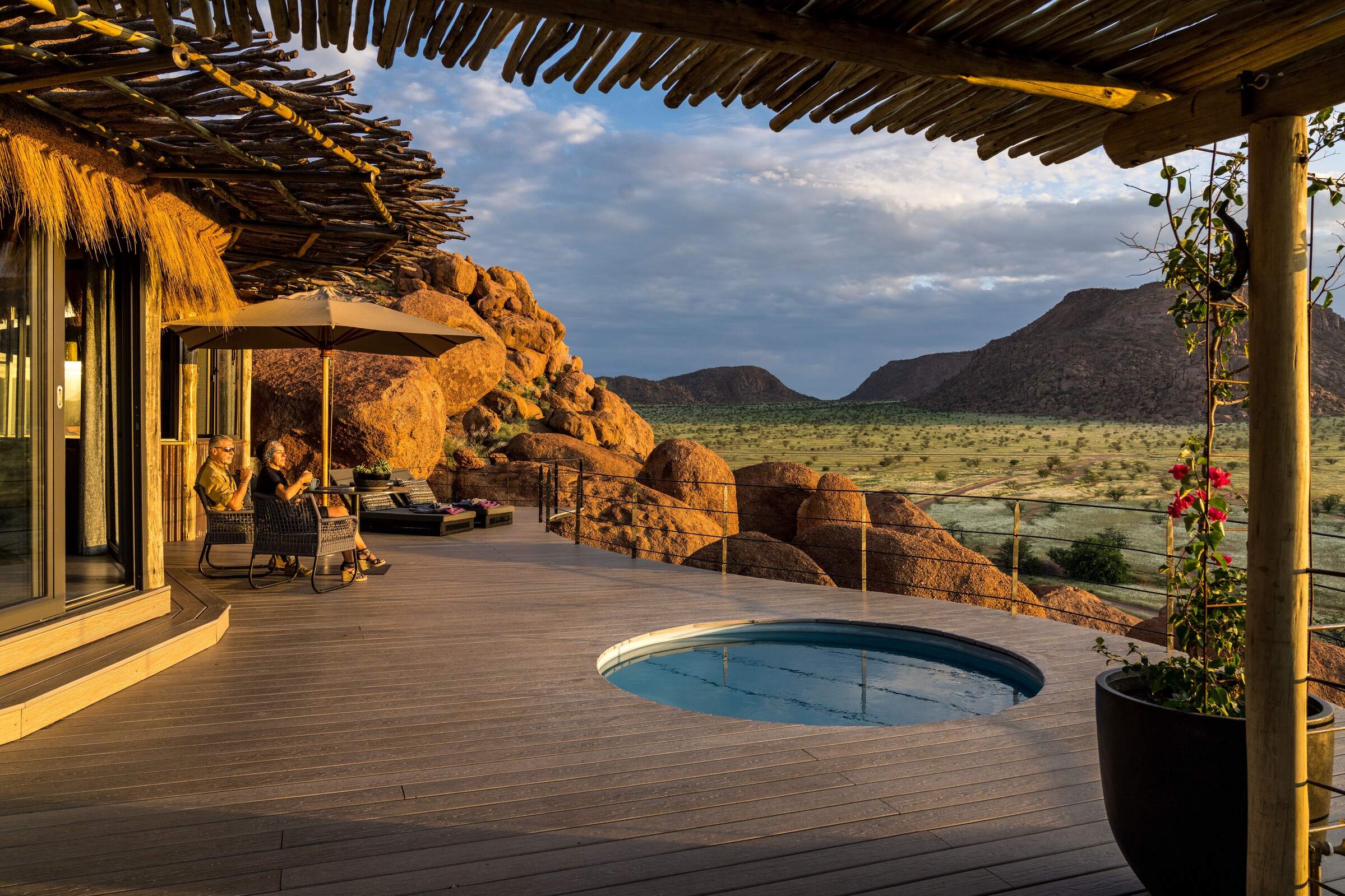
Camp Kipwe
With unusual, igloo-like rooms, open-air bathrooms and beautiful scenery, Camp Kipwe is well placed for nature and cultural excursions.
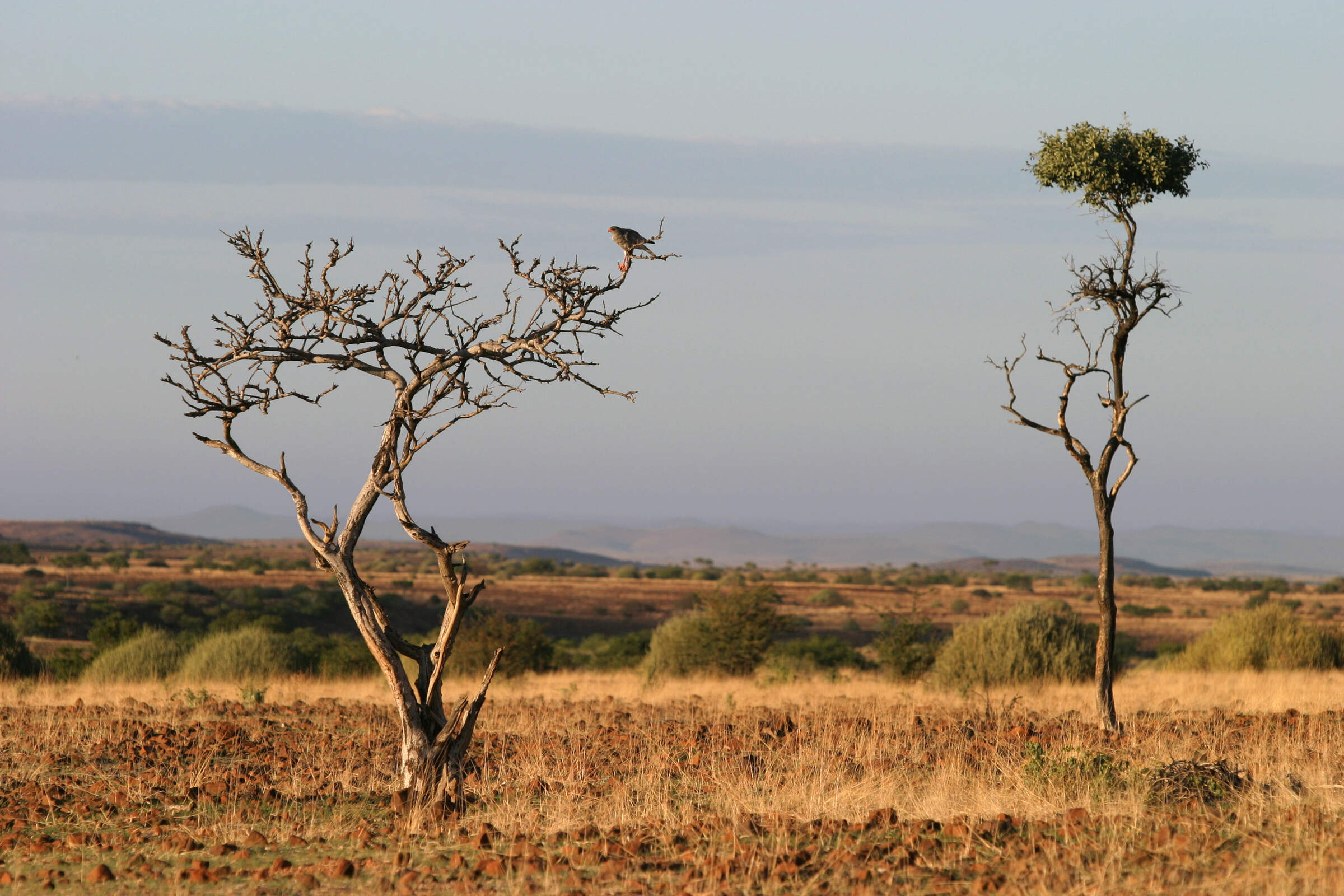
Etendeka Camp
Etendeka is an owner-run camp in the remote and less visited north of Damaraland. The camp is renowned for it's spectacular guided walking trails.
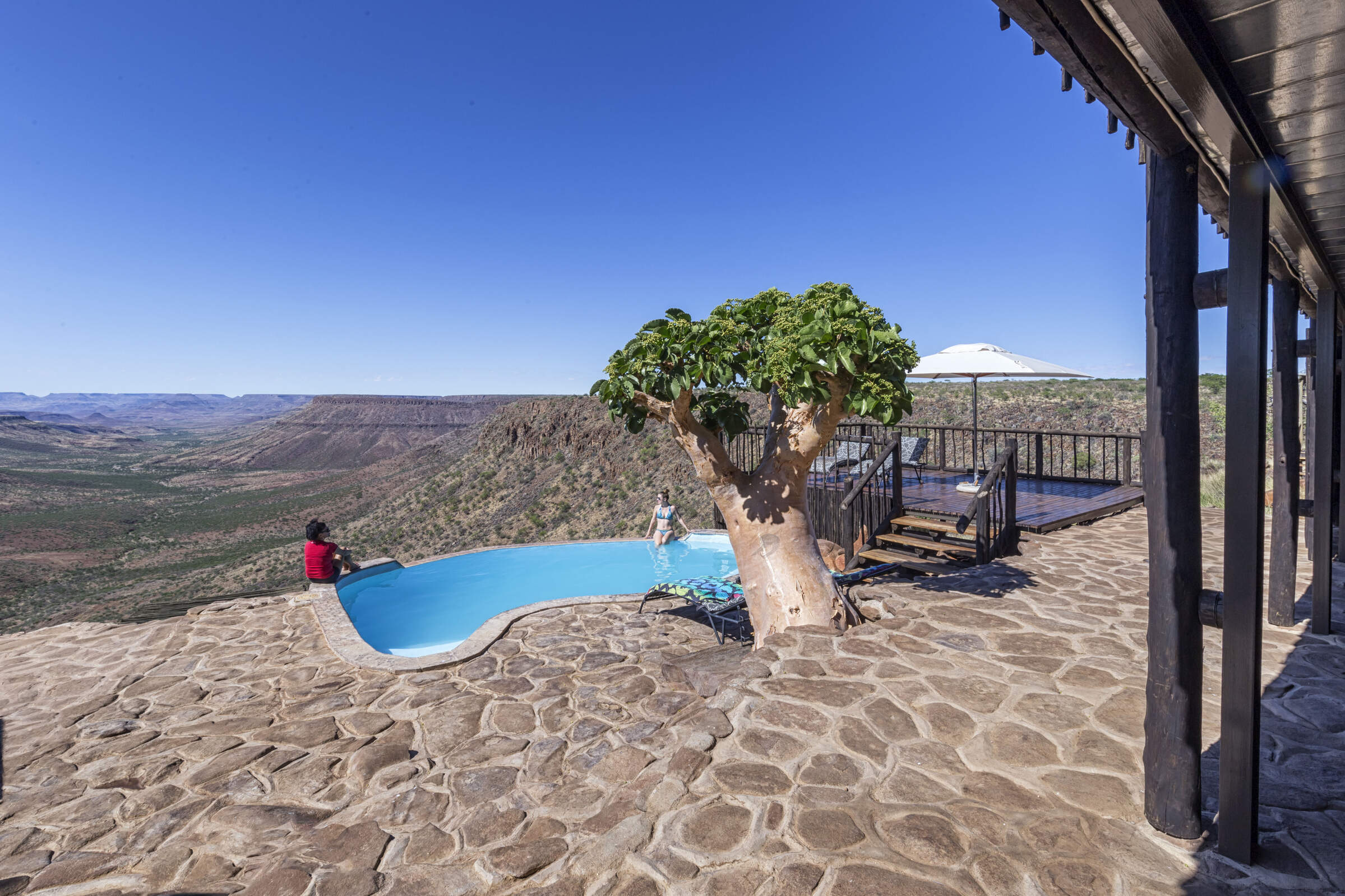
Grootberg Lodge
On the edge of an ancient plateau Grootberg Lodge has a stunning location and arguably the best views of any lodge in Namibia.
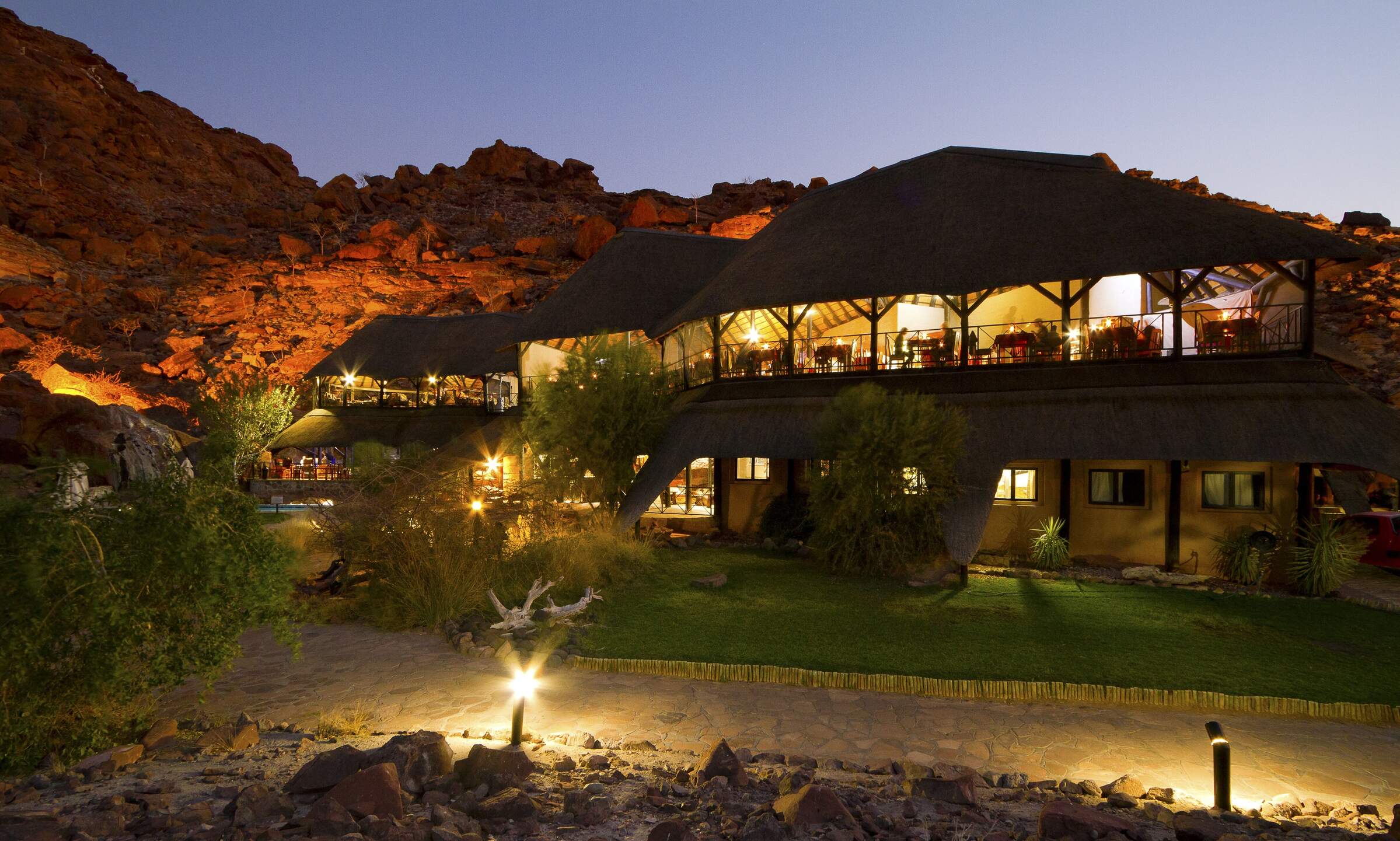
Twyfelfontein C'try Lod.
A large lodge set among the rocks, Twyfelfontein Country Lodge is a convenient base for visiting the rock engravings, which are only 4km away.
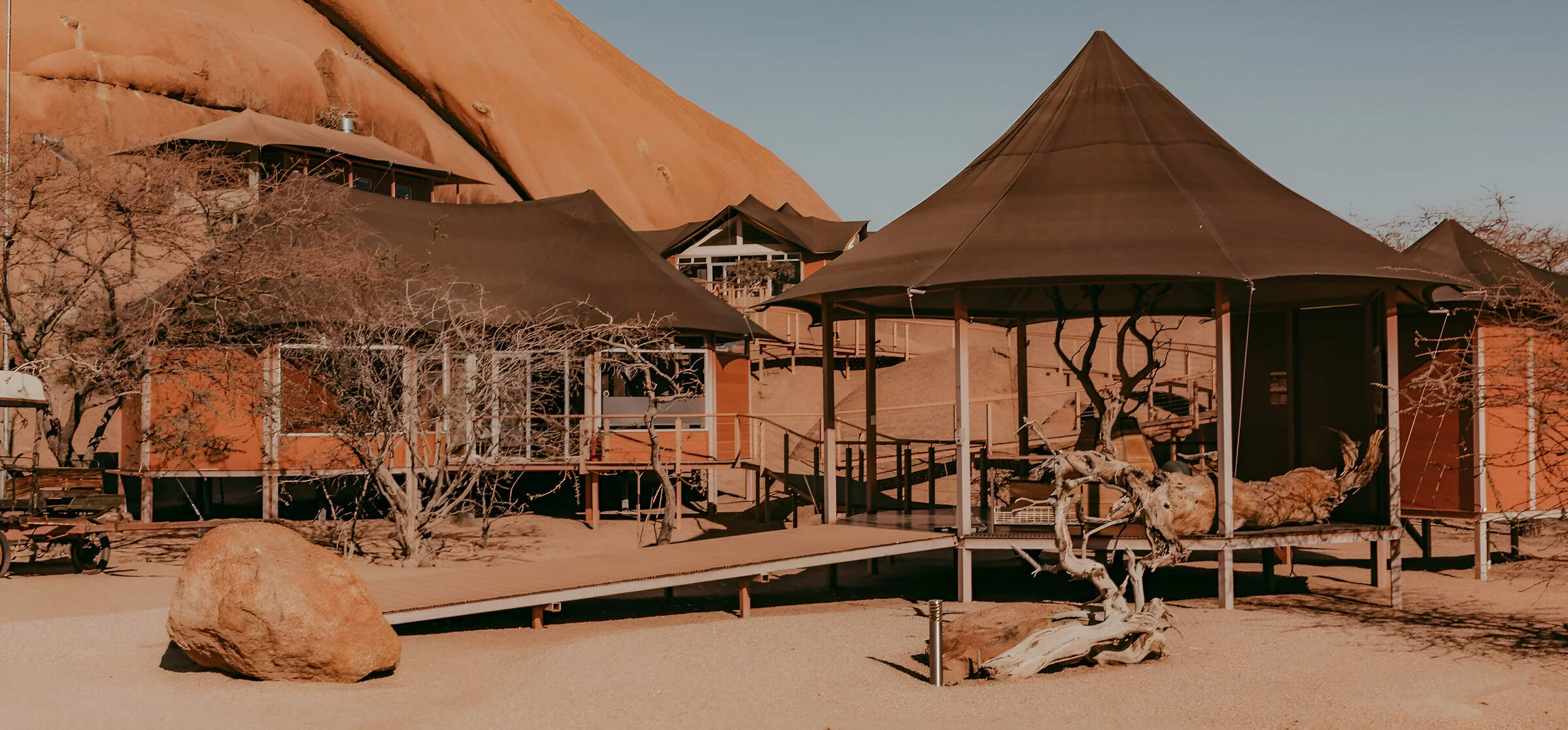
Spitzkoppen Lodge
Spitzkoppen Lodge provides stylish accommodation in an area of scenic grandeur with guided access to sites of ancient Bushman rock art.
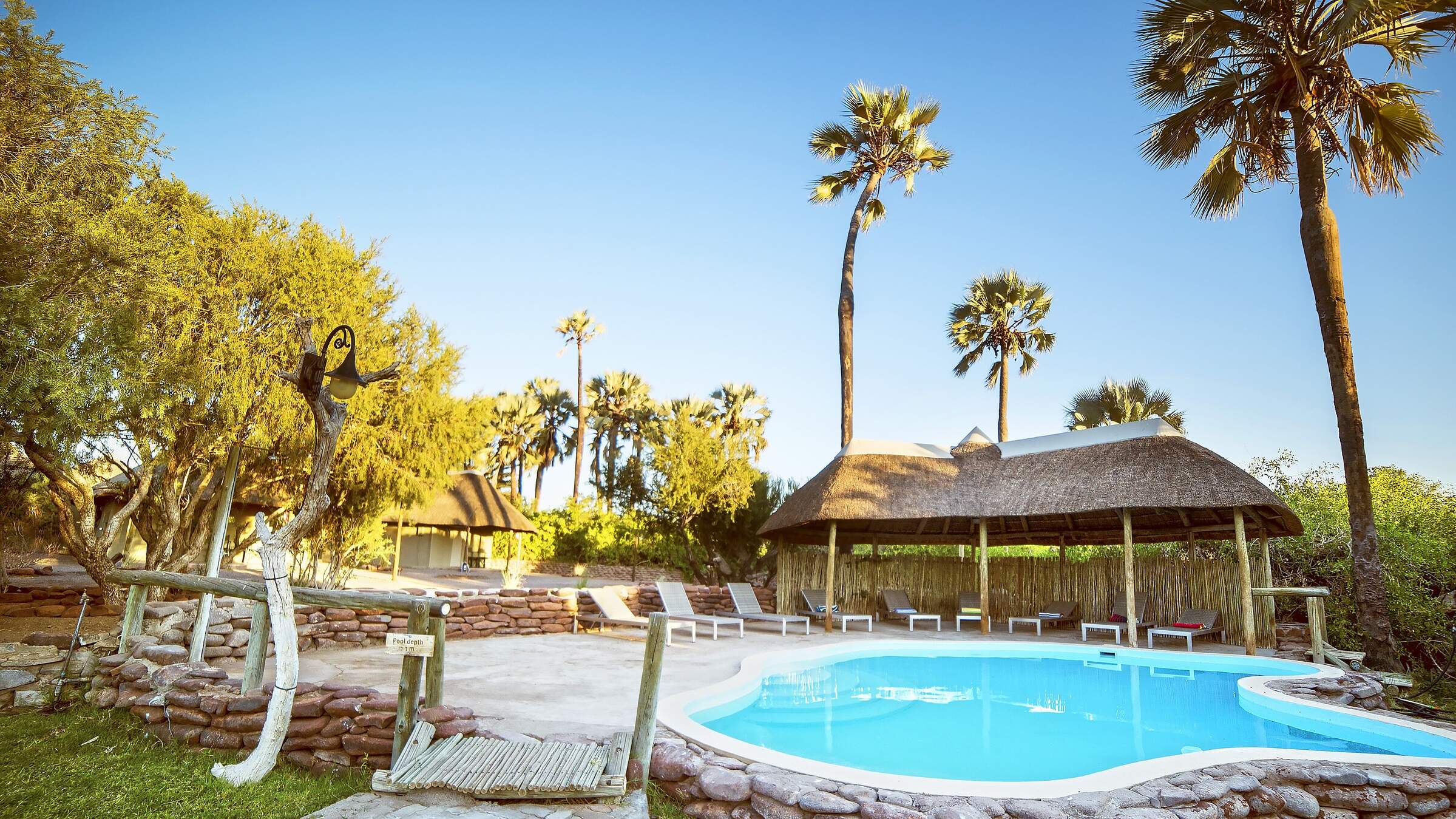
Palmwag Lodge
Palmwag Lodge has a great location by a spring in the Uniab River and offers access to an area where you can see a variety of desert-dwelling animals.
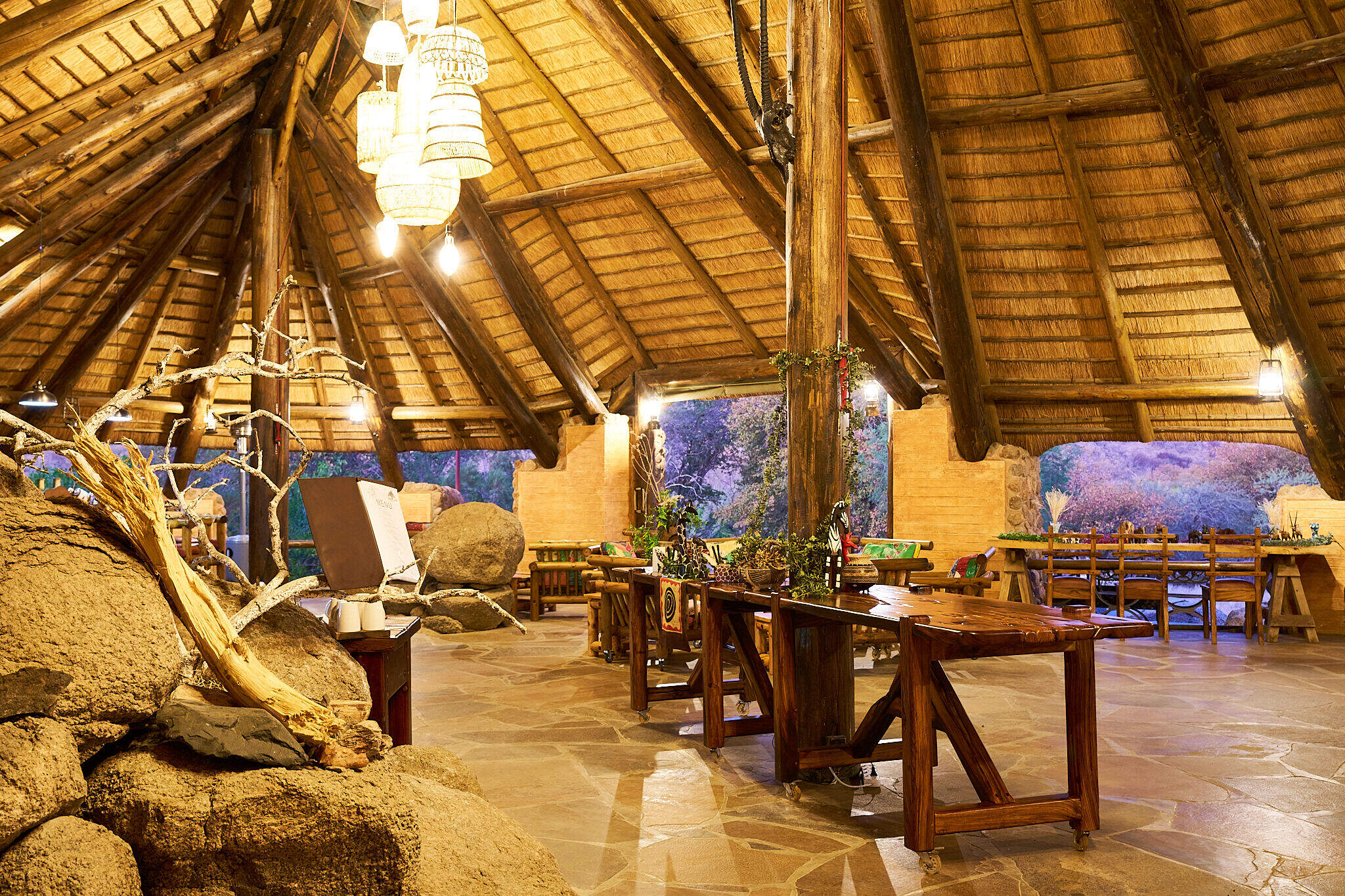
Huab Lodge
Huab is a classic little Namibian Lodge which is slightly off the beaten track in a lesser visited part of Damaraland.
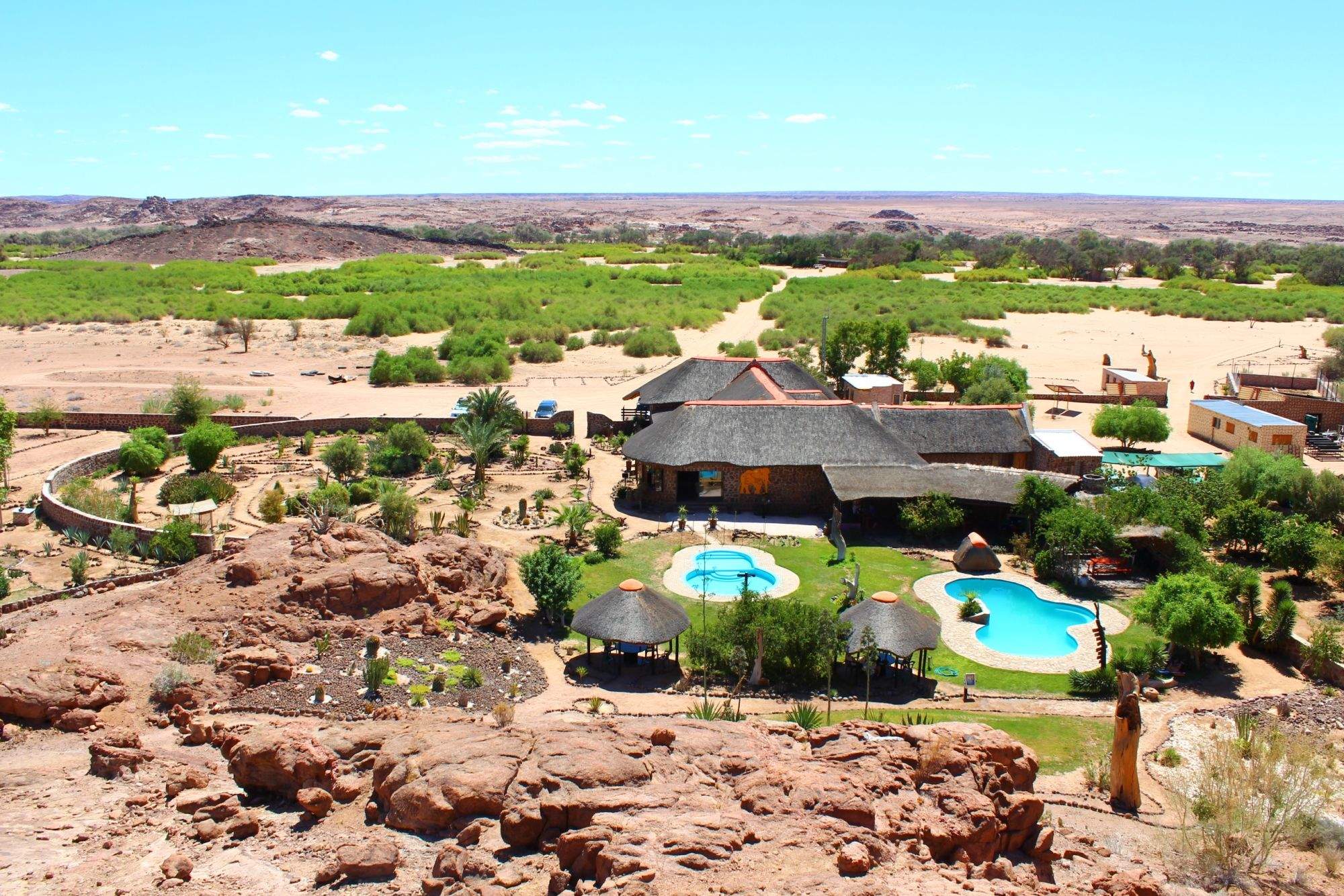
Brandberg White Lady
Brandberg White Lady Lodge, nestled at the foot of its namesake, makes a good base from which to visit bushman rock paintings including the 'White Lady'.
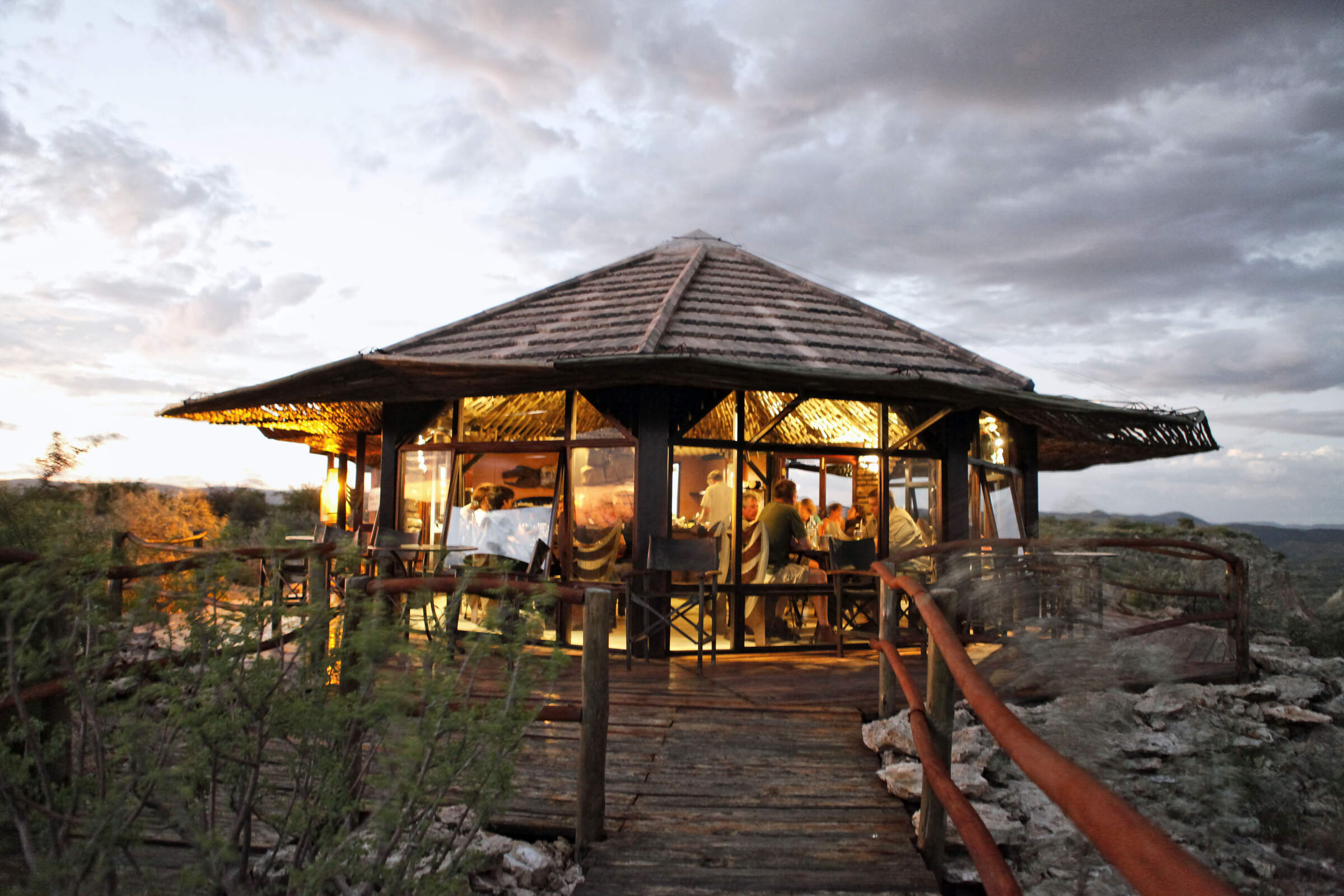
Vingerklip Lodge
Vingerklip Lodge occupies a lovely location, but is a little too far east for guests to visit Damaraland's main attractions.
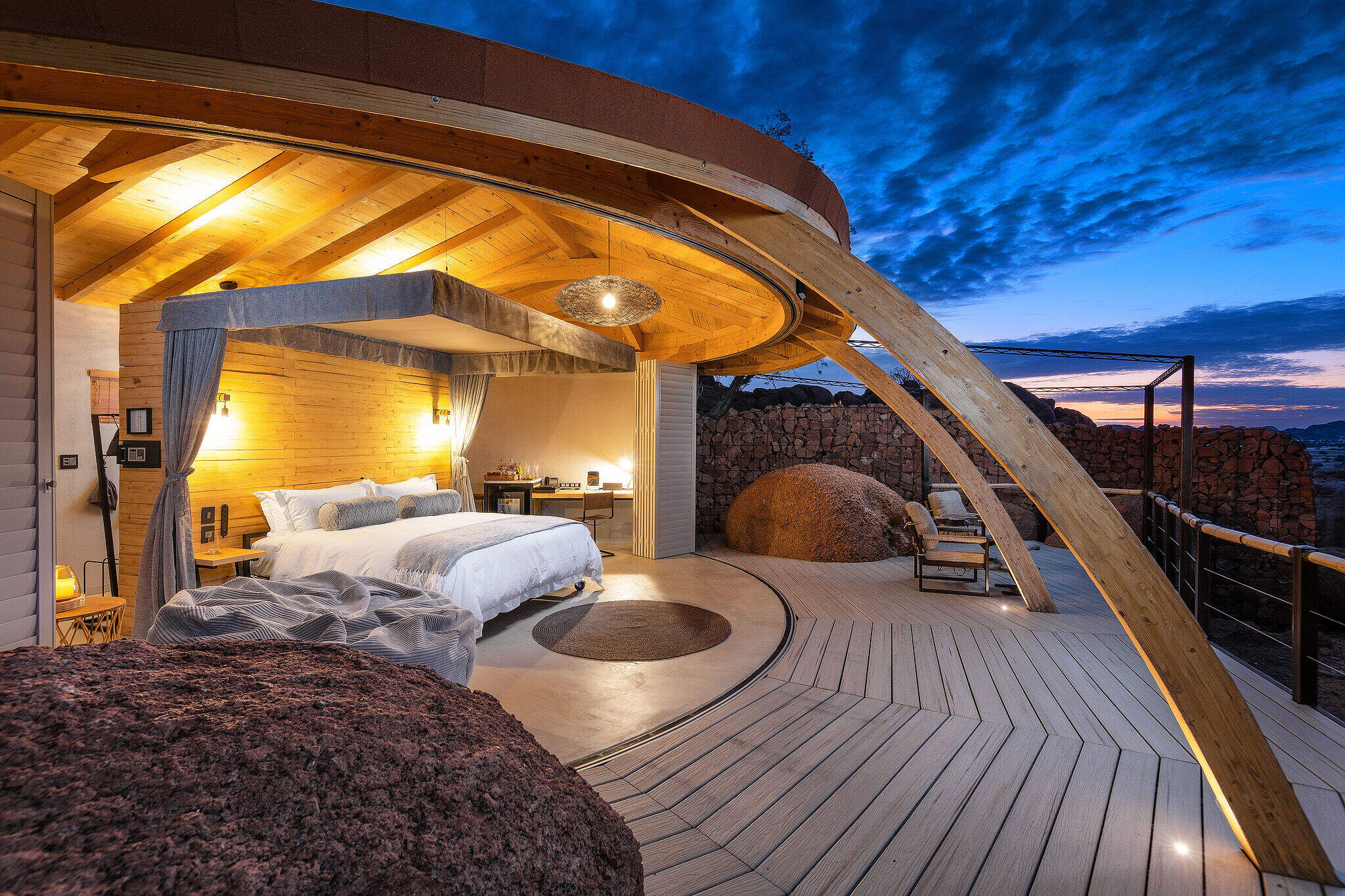
Onduli Ridge
Onduli Ridge is a luxurious, low-impact luxury camp offering top-notch guiding in a remote wilderness area of Damaraland.
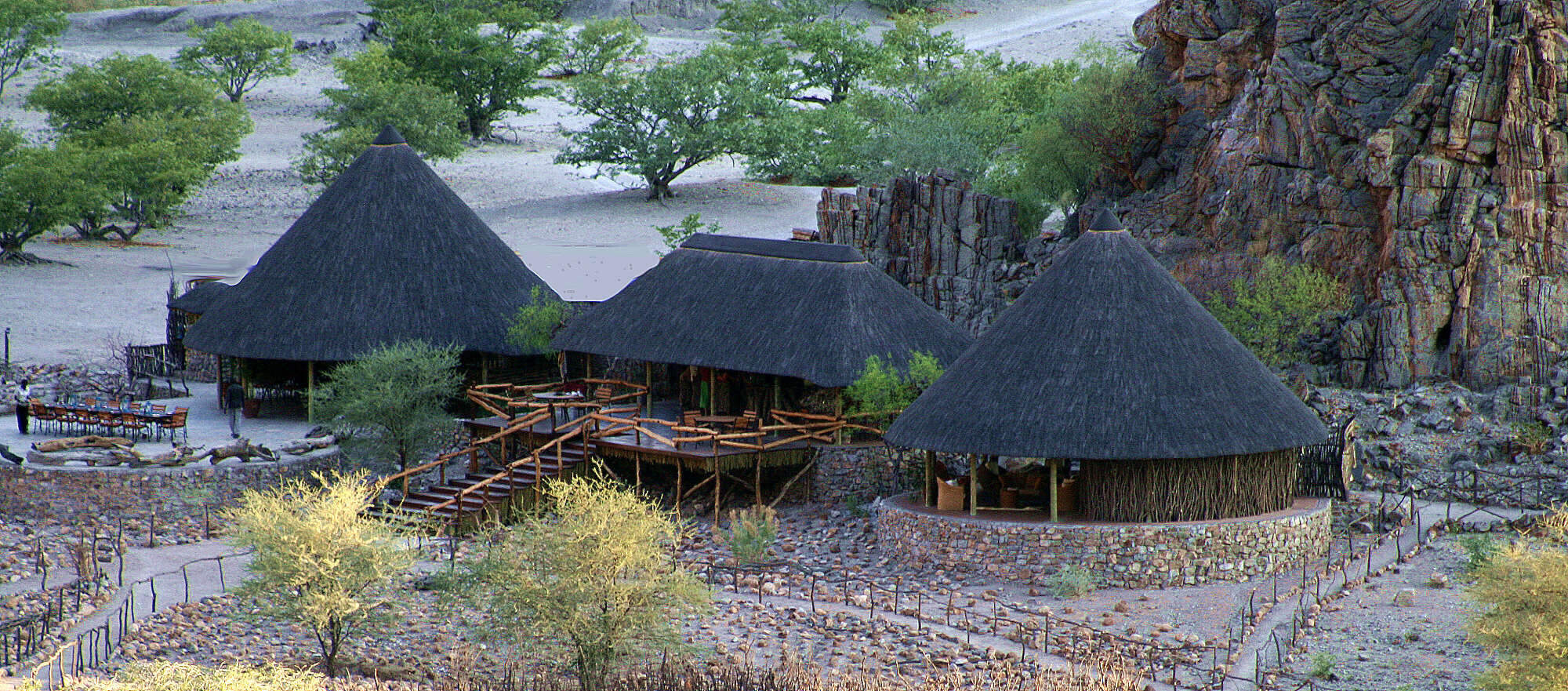
Khowarib Lodge
Khowarib Lodge has a great location overlooking the Hoanib River. This is one of the few places to offer authentic Himba village visits.
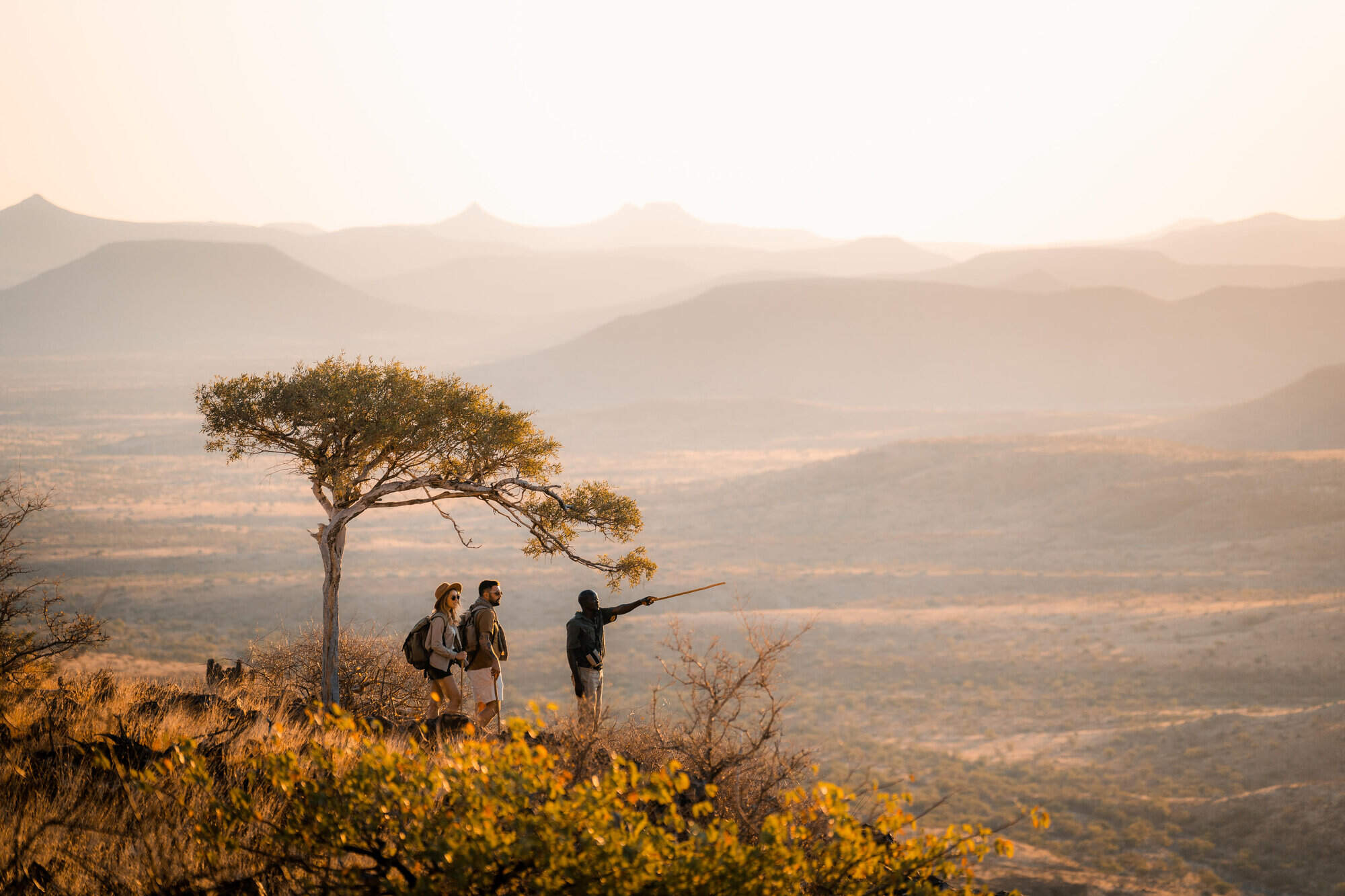
Etendeka Hiking Trail
The Etendeka Walking Trail promises to offer a back-to-basics walking and camping experience in one of Namibia's most remote and untouched wilderness areas.
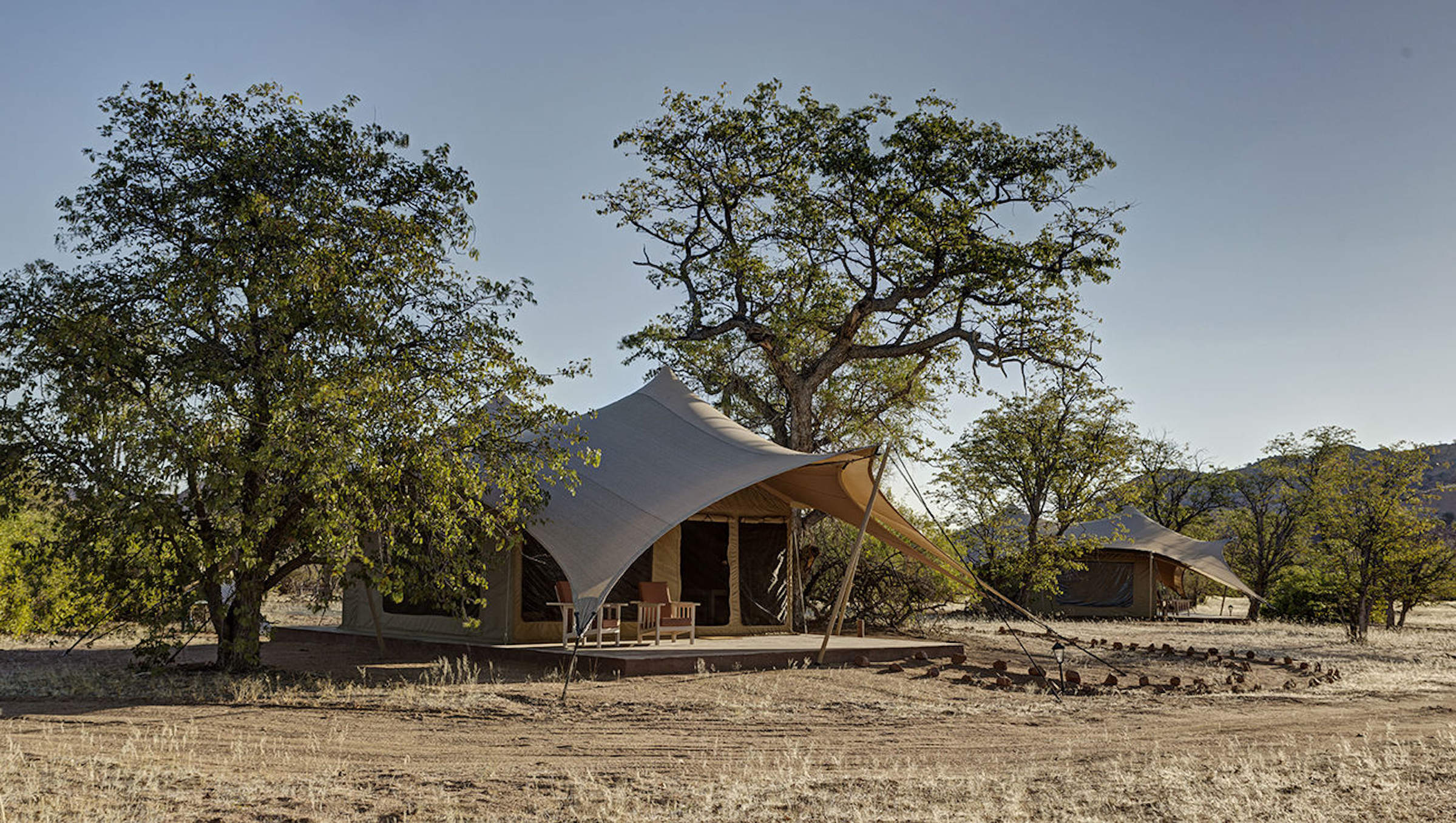
Malansrus Camp
Within easy reach of Twyfelfontein, Malansrus offers a simple but comfortable base for visits to the rock engravings or seek out desert-adapted elephants.
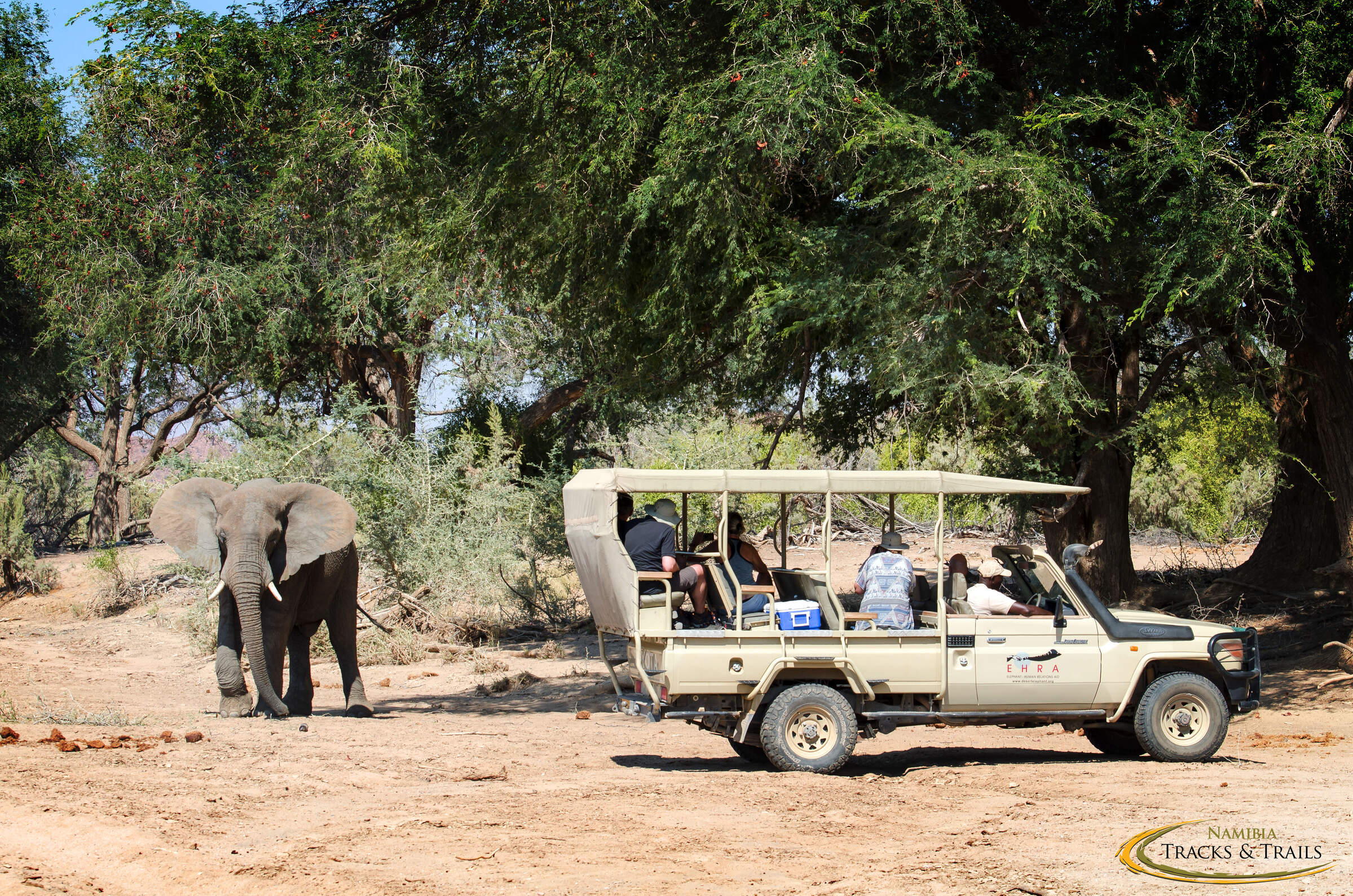
Ozondjou Trails
The simple Ozondjou Trails gives a unique perspective on living with Damaraland’s desert-adapted elephants and how tourism is key to protecting them and the livelihood of the people.
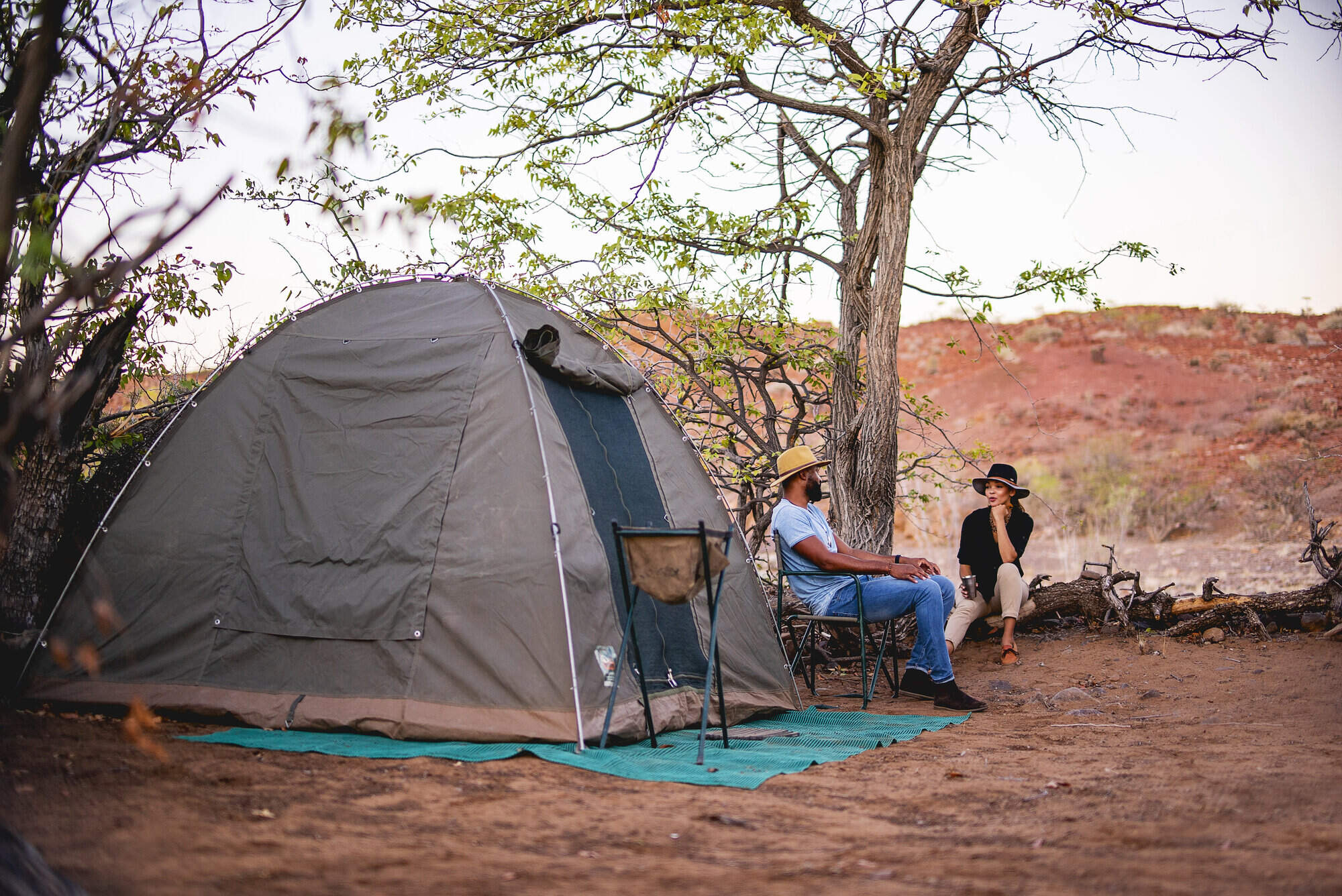
Palmwag Sleep-out
Palmwag Sleep-out is a simple camping experience and a great way to enjoy the remote beauty of the vast Palmwag Concession
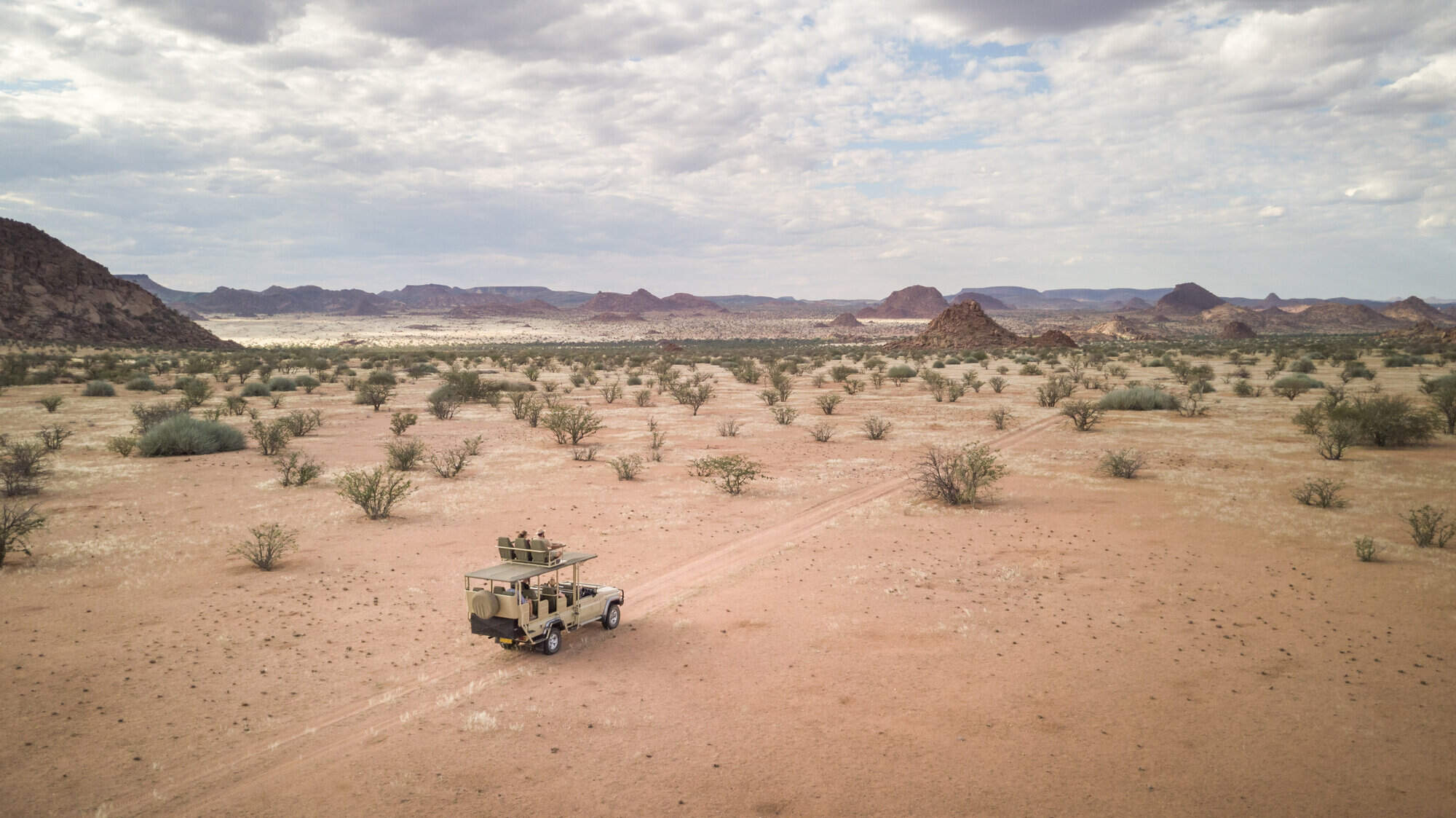
Camp Doros
Small, intimate and with excellent eco-credentials, Camp Doros is set above an ephemeral river within a remote community concession of Damaraland.
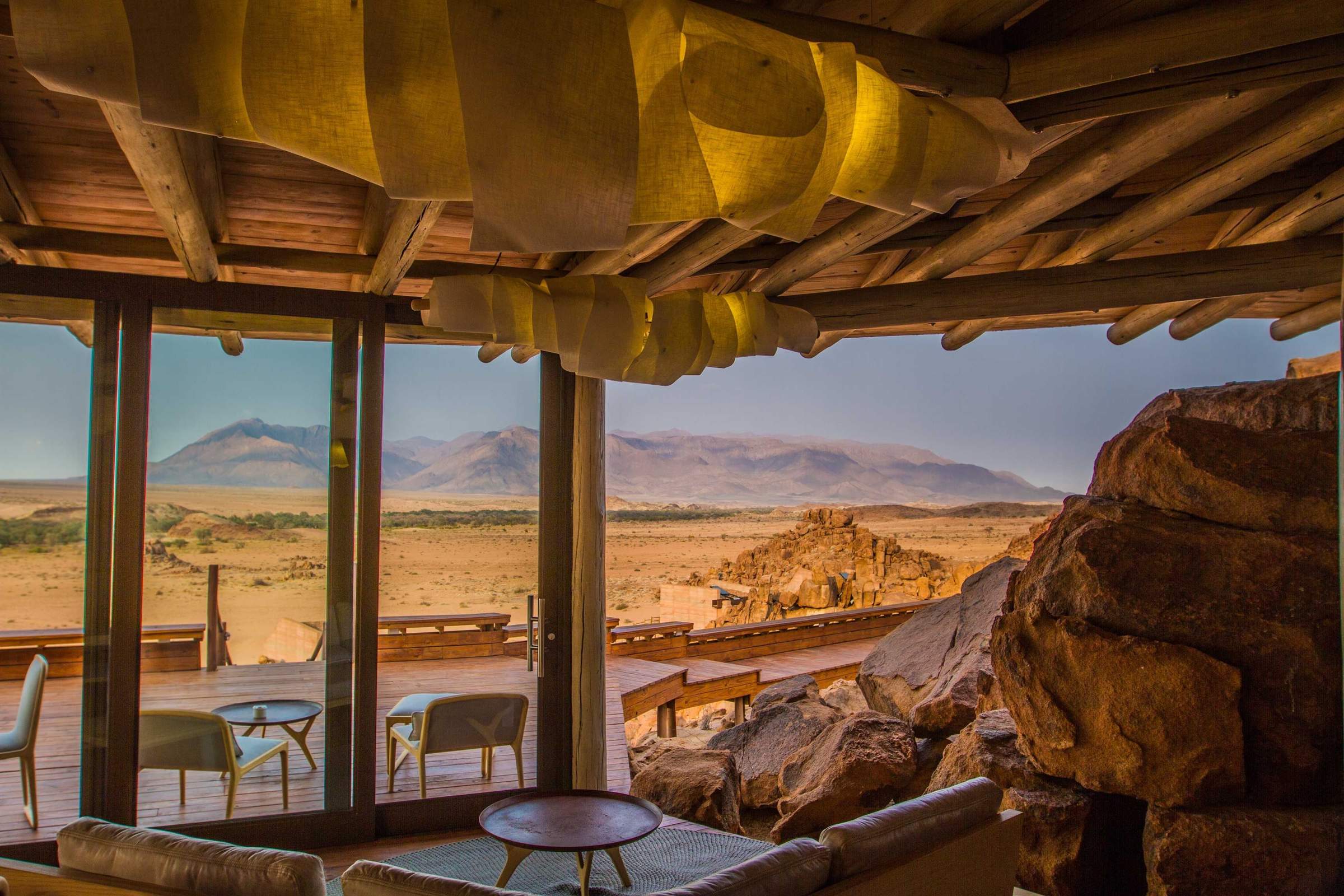
Sorris Sorris Lodge
Overlooking the Brandberg Massif, Sorris Sorris is probably the most luxurious lodge in southern Damaraland.
When to go to Damaraland
Our month by month guide: What it's like to visit Desert Rhino Camp in Damaraland
Jan
Feb
Mar
Apr
May
Jun
Jul
Aug
Sep
Oct
Nov
Dec
Damaraland in January
In Damaraland, January marks the start of the rainy season. The rains, though often light and localised, bring life to the desert landscape.
At Twyfelfontein, the rock engravings glisten after sporadic showers. Some days are clear and hot, with temperatures around 30°C/86°F, while others see dramatic thunderstorms. These can create flash floods in ephemeral riverbeds like the Ugab, temporarily transforming the arid terrain. The greening landscape provides a refreshing backdrop for the ancient rock art at Brandberg Mountain.
Many birds in the region are in full breeding plumage, with migrant species adding to the variety. Wildlife, including the desert-adapted elephants, disperses across the rejuvenated landscape, making sightings more challenging, but rewarding. The Damara Living Museum offers insights into how local communities adapt to these seasonal changes.
- Variable weather: hot, dry or humid with rain
- Occasional localised thunderstorms
- Wildlife dispersed, harder to spot
- Stark mountains against atmospheric skies
- Few tourists, low rates at accommodations
Our view
This is not a great time to visit
Weather in January
Damaraland in February
February is typically the wettest month in Damaraland, though rainfall remains patchy across this predominantly arid region.
The Spitzkoppe granite peaks against thunderous, atmospheric skies create dramatic vistas for photographers. Some days are clear and hot, while others see afternoon thunderstorms that briefly but dramatically charge the landscape. These rains can make travel more challenging, especially to remote sites like the Epupa Falls. However, the landscape feels vibrant and alive, with insects and smaller animals more easily spotted, and seasonal flowers blooming. Many birds and animals are raising their young, offering unique wildlife viewing opportunities.
Despite the rains, the rock art at Twyfelfontein and the Petrified Forest remain accessible.
- Hot and humid with occasional rain showers
- Thunderstorms meander over the landscape
- Birdlife spectacular, migrant species present
- Wildlife harder to see, but landscape lush
- Low tourist numbers, great for solitude
Our view
This is not a great time to visit
Weather in February
Damaraland in March
March in Damaraland usually sees the main rains tailing off, though precipitation varies greatly across the region. Many days are clear, with strong sun driving temperatures up, while others may experience light rainfall.
The landscape often appears vivid and green, providing a striking contrast to the bare rocky outcrops of Spitzkoppe and Brandberg. Animals such as springbok and mountain zebra may be finishing raising their young. Small herds of plains game such as these can be more visible against the greener backdrop. The Damara Living Museum showcases how local communities adapt to these seasonal changes. The clearer skies towards the end of the month make for excellent stargazing at lodges where you can move your bed to sleep under the stars.
- Weather becoming drier as month progresses
- Animals looking healthy after months of plenty
- Balmy nights sleeping under star-filled skies
- Migrant birds begin to depart
- Few tourists, rates often low at lodges
Our view
A good time to visit, with pros & cons
Weather in March
Damaraland in April
April in Damaraland is typically dominated by dry weather, with decreasing chances of rain. Temperatures begin to fall, but days remain pleasantly warm. The rains often leave the landscape verdant, creating stunning photo opportunities at sites like the Etendeka Plateau and Klip Valley.
Animals are in fantastic condition, often with fast-growing young in attendance. The desert-adapted elephants may be more easily spotted as they begin to return to the riverbeds to feed on Ana and Camelthorn trees. With dust washed from the atmosphere, photographers can capture clear shots of spectacular landscapes. Stargazers will enjoy increasingly clear night skies. In the Palmwag Concession, water and food remain in plentiful supply, so finding mammals such as black rhino can still be challenging, but worth the effort.
- Cooler nights, days still warm and pleasant
- Landscape still green from recent rains
- Air clear, for crisp photographs
- Wildlife starting to become easier to find
- Easter sees an increase in visitors
Our view
A good time to visit, with pros & cons
Weather in April
Damaraland in May
By May, Damaraland is usually drying out fast. If rains have been good, the land remains green, especially around natural springs found in valleys and craggy rocksides. The air quality and clarity can be amazing, making this an ideal month for photography at sites like Twyfelfontein and along the remote Hoanib riverbed.
Temperatures are moderate, typically warm with crisp, clear mornings and blue skies. Evenings are cool enough to wear an extra layer. Many lodges still charge low season prices, offering good value. The combination of increasingly good wildlife sightings, beautiful landscapes, and crystal-clear air make May one of the best months to visit Damaraland. It's an excellent time to explore the region's geological wonders, such as the ancient Etendeka lava flows.
- Lovely weather: warm days, cool nights
- Landscape drying out, still some greenery
- Clear, sharp colours for photography
- Wildlife more visible along scenic riverbeds
- Low visitor numbers, moderate lodge rates
Our view
A very good time to visit
Weather in May
Damaraland in June
June sees Damaraland dry and clear, with blue, largely cloudless skies. Days are often lovely and warm, but nights can be cold, sometimes below freezing in desert areas.
Visitors should pack warm clothing for early morning nature drives to spot desert-adapted elephants or black rhinos. Most outdoor pools are too cold for swimming, except for the very dedicated. It’s a particularly good climate for walking; either short walks or perhaps a multi-day hike on the Etendeka Plateau.
Historically, June prices have been low, but Damaraland's increasing popularity means many lodges now consider it high season.
- Clear, bright days and cold nights
- Wonderful for stargazing and night walks
- Good wildlife viewing in remote wildernesses
- Hiking comfortable in cooler temperatures
- Moderate lodge rates, increasing bookings
Our view
A very good time to visit
Weather in June
Damaraland in July
July in Damaraland offers fairly warm temperatures above 20°C/68°F in the middle of the day, but often cold nights. Visitors should dress in layers and be prepared for chilly mornings and evenings.
Rain is extremely rare, and clear skies make for great photographs of the sandstone mountains in morning and evening light. As vegetation shrivels, animals gather near food and water sources, making sightings of desert-adapted wildlife more likely. Elephant herds are more regularly seen along dry riverbeds during this period.
Lodges charge high season rates, and many are booked up well in advance, especially during European school holidays.
- Dry days, clear skies, crisp cold nights
- Peak time for wildlife viewing in Damaraland
- Desert-adapted elephants more easily spotted
- Wonderfully cool for day walks and longer hikes
- High season rates, book accommodations early
Our view
A very good time to visit
Weather in July
Damaraland in August
August is the height of Damaraland's winter. Expect cloudless skies and usually warm sun during the day, but nights can drop to freezing in desert areas. Visitors should bring warm clothes for nature drives and walks in chilly mornings and evenings.
The landscape begins to change from green to golden grasses and stark hillsides. Wildlife sticks close to dry river-beds where desert-adapted elephants dig for water, creating waterholes for other animals.
The clear, dry conditions make it an excellent time for hiking and exploring geological features like the Organ Pipes and Burnt Mountain.
August is the most popular time to visit Damaraland, especially for families. Booking well in advance is essential.
- Perfect weather for outdoor activities
- Excellent wildlife viewing opportunities
- Popular time for hiking and tracking rhino on foot
- Good time for cultural experiences at Damara Living Museum
- Peak season, lodges booked up well in advance
Our view
Fantastic: the very best time to visit
Weather in August
Damaraland in September
September in Damaraland brings blue, cloudless skies and fantastic wildlife viewing. Rain is almost unheard of, and as the month progresses, days and nights quickly get warmer. Daily maximums can reach the low 30s Celsius/mid-80s Fahrenheit, though low humidity keeps it comfortable. The air becomes dustier, occasionally affecting visibility for photographers at sites like Twyfelfontein or Brandberg.
In the Palmwag Concession and along the Ugab River, animals congregate around remaining water sources, making September one of the best months for game viewing, especially for desert-adapted elephants and black rhinos, but also desert-adapted lion. It's a popular month for visitors, particularly safari enthusiasts seeking sightings of these unique sub-species.
The Himba at Khowarib provide insights into how local communities adapt to the dry season.
- Warm days, nights getting warmer
- Landscape golden brown, very photogenic
- Prime time for seeing desert-adapted wildlife
- Air can be hazy with dust
- High season rates, book well in advance
Our view
Fantastic: the very best time to visit
Weather in September
Damaraland in October
Damaraland is usually at its hottest and driest in October. Temperatures build throughout the month, with daily highs potentially exceeding 40°C/104°F towards the end. The extreme dryness, though, makes even these high temperatures bearable.
Wildlife watching is at its best, particularly in areas like the remote Palmwag Concession and along the Hoanib River. October is popular among wildlife enthusiasts, as shyer species such as brown hyena and cheetah are more regularly seen. However, dust and occasional smoke may make the air hazy, challenging landscape photographers but creating beautiful sunsets.
Visitor numbers can decrease towards the end of the month, potentially allowing for last-minute bookings at some lodges.
- Hot and dry, true desert conditions
- Wildlife congregates at remaining water
- Excellent month for photographing sunsets
- Peak tourist time, expect higher rates
- Unusual species like brown hyena more regularly seen
Our view
A very good time to visit
Weather in October
Damaraland in November
November in Damaraland is unpredictable; sometimes dry and hot, sometimes cloudier and cooler. Typically, mornings are hot and clear, with clouds gathering from the afternoon. Humidity builds, occasionally resulting in spectacular thunderstorms with convection rainfall in late afternoons. These storms are usually localised and may not reach desert areas.
Places receiving good rain, like parts of the Palmwag Concession, quickly turn green, softening the landscape. Many mammals give birth, offering unique wildlife viewing opportunities. Once rains settle in waterholes, wildlife disperses in search of food, making game viewing more challenging. However, this is an excellent time for birdwatchers, with migrant species arriving and taking on breeding plumage.
The rock art at Twyfelfontein and Brandberg can be particularly striking after light rains.
- Variable weather, possibility of rain
- New growth if rains arrive, landscape greens
- Wildlife viewing still good, with babies often born
- Shoulder season rates offer better value
- Birdlife increases with migrant arrivals
Our view
A good time to visit, with pros & cons
Weather in November
Damaraland in December
December is often a dry month between November’s short rains and the main rains in January, and is one of its hottest months. Occasional short, often spectacular thunderstorms are often highly localised and generally welcomed, clearing the air of dust and allowing plant life to flourish. This creates a green carpet across the usually arid landscape, providing food for young animals.
Wildlife, including the desert-adapted elephants, disperses widely as food is more plentiful, making game viewing in areas like the Palmwag Concession more challenging. But sightings in early December can be enjoyed and photographed at leisure often with few or no other viewers. Many birds are breeding, sporting their most colorful plumage.
Christmas and New Year fall within local summer holidays, so accommodation options can be surprisingly busy, especially in cooler areas near the coast.
- Hot days, possibility of refreshing showers
- Landscape may become green with early rains
- Good time for seeing young animals
- Desert-adapted species less concentrated
- Holiday season brings more visitors
Our view
This is not a great time to visit
Weather in December

Looking for inspiration on where to travel next?
Visit our trip chooser to explore your options and find inspiration for your perfect African adventure
Inspire me